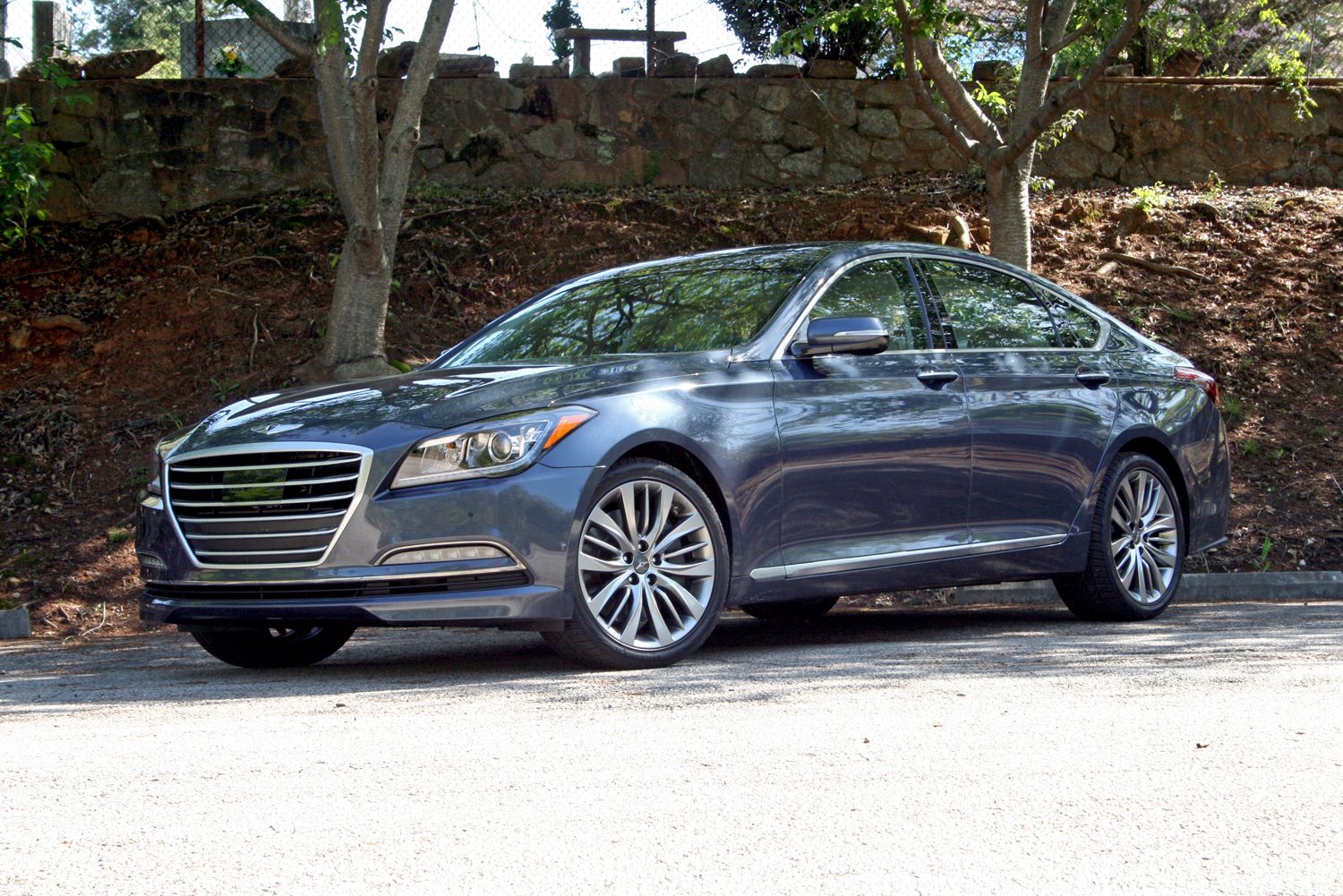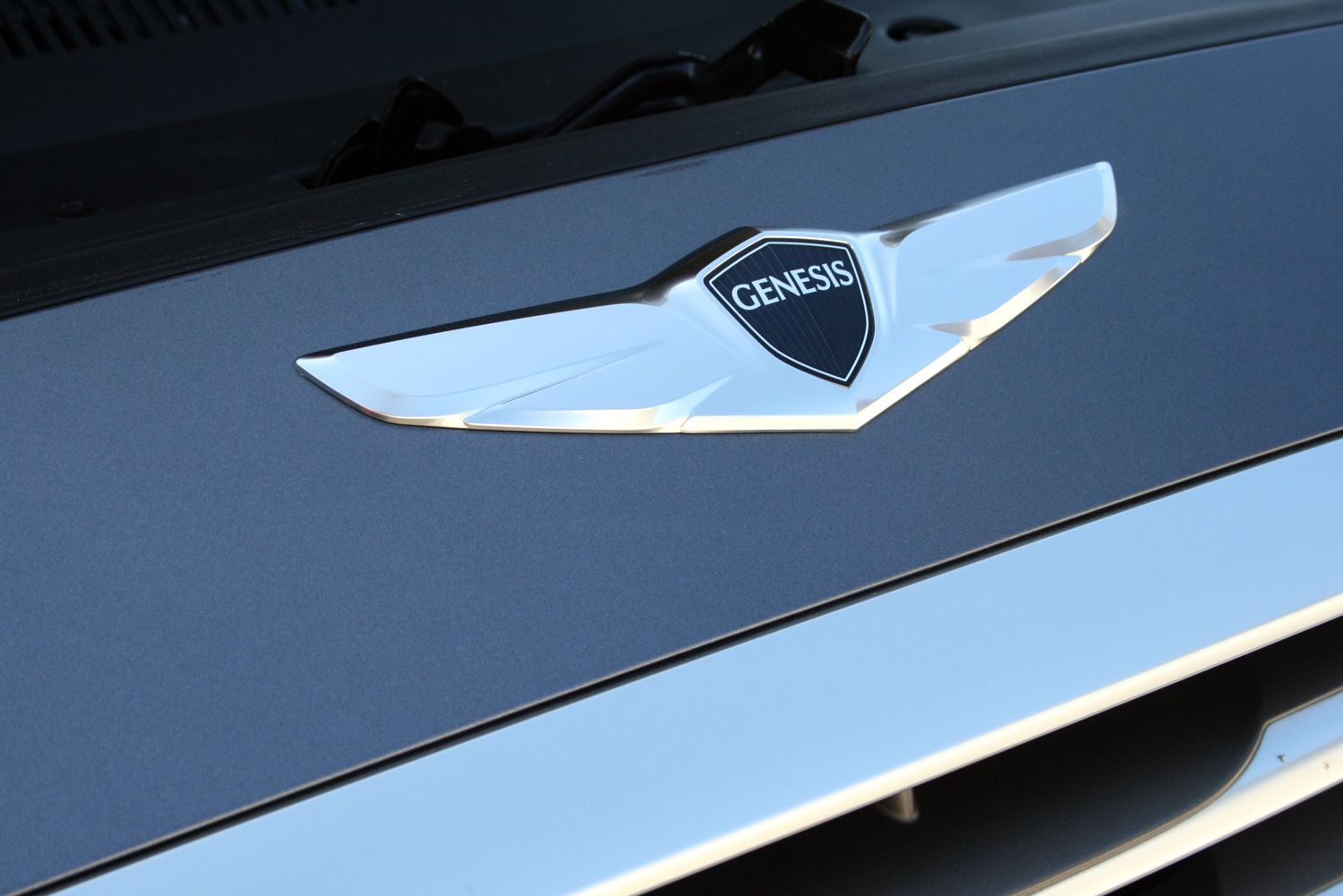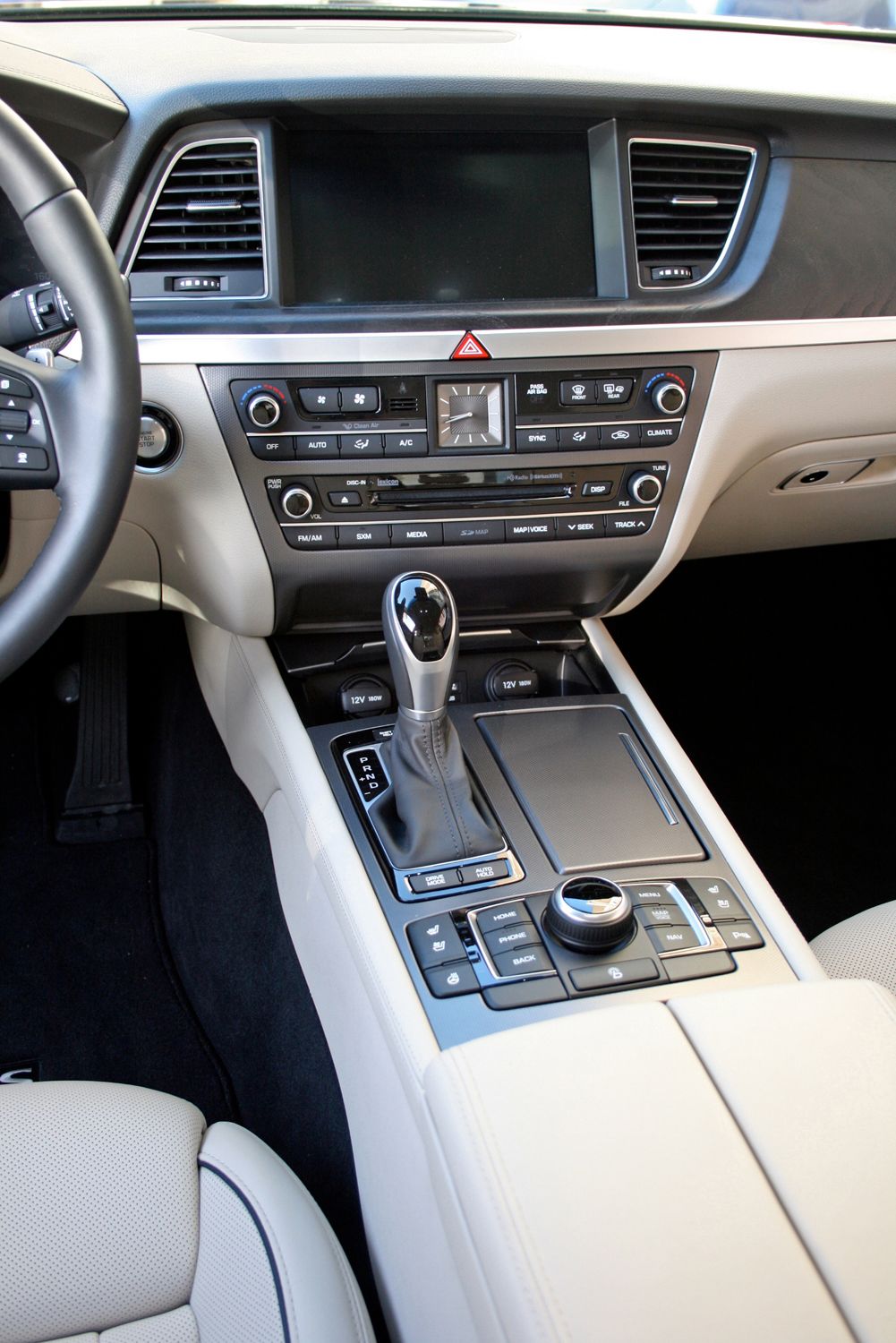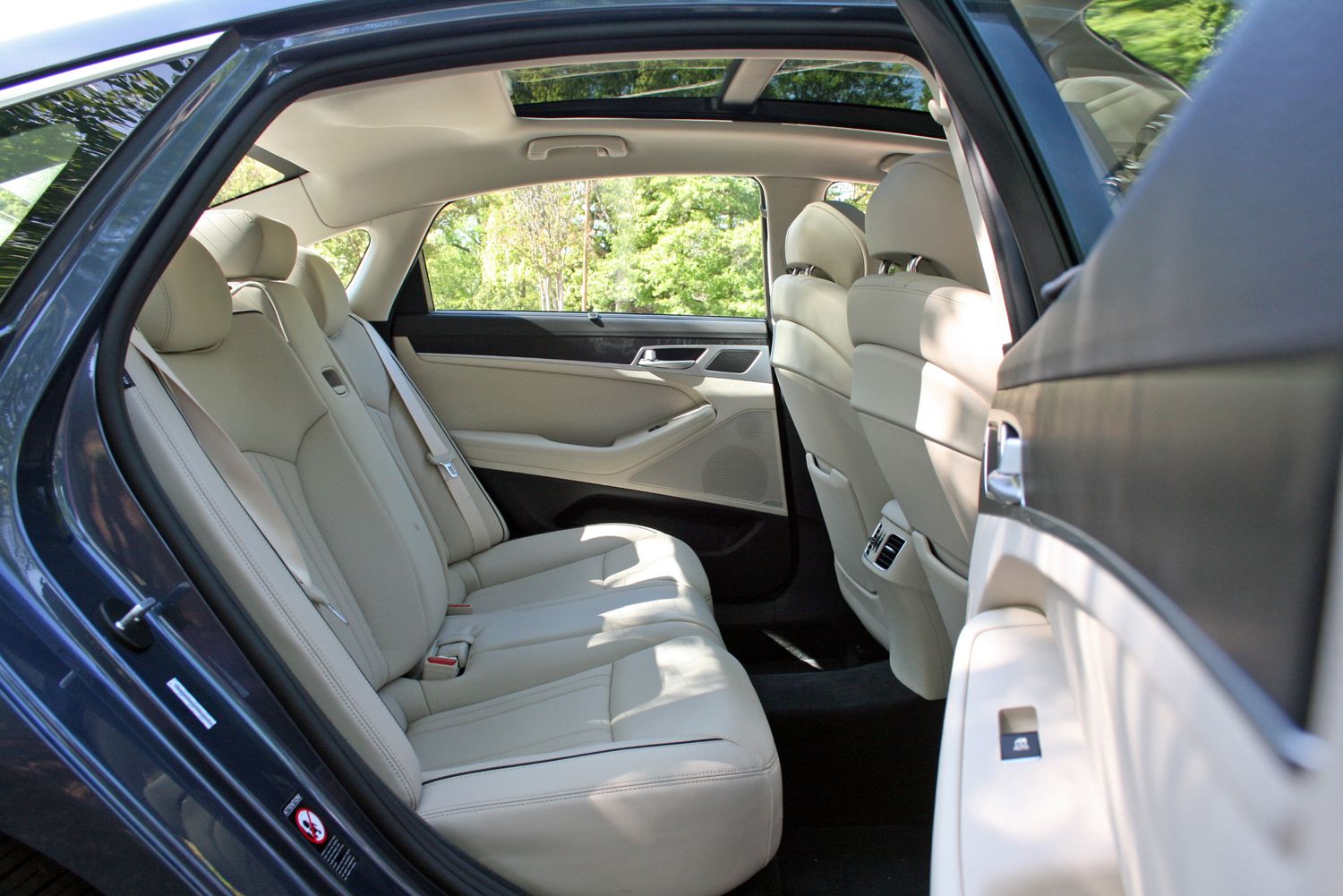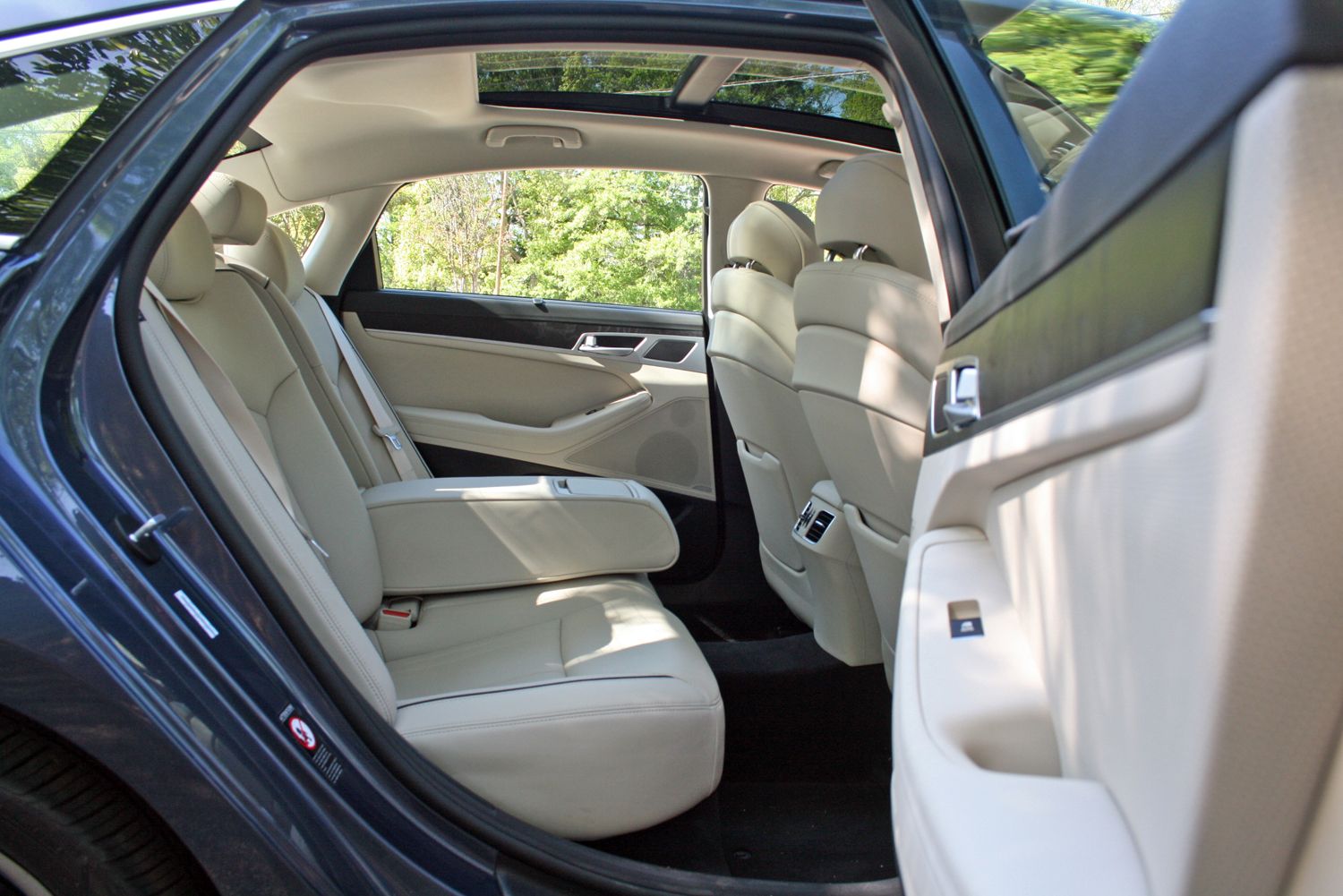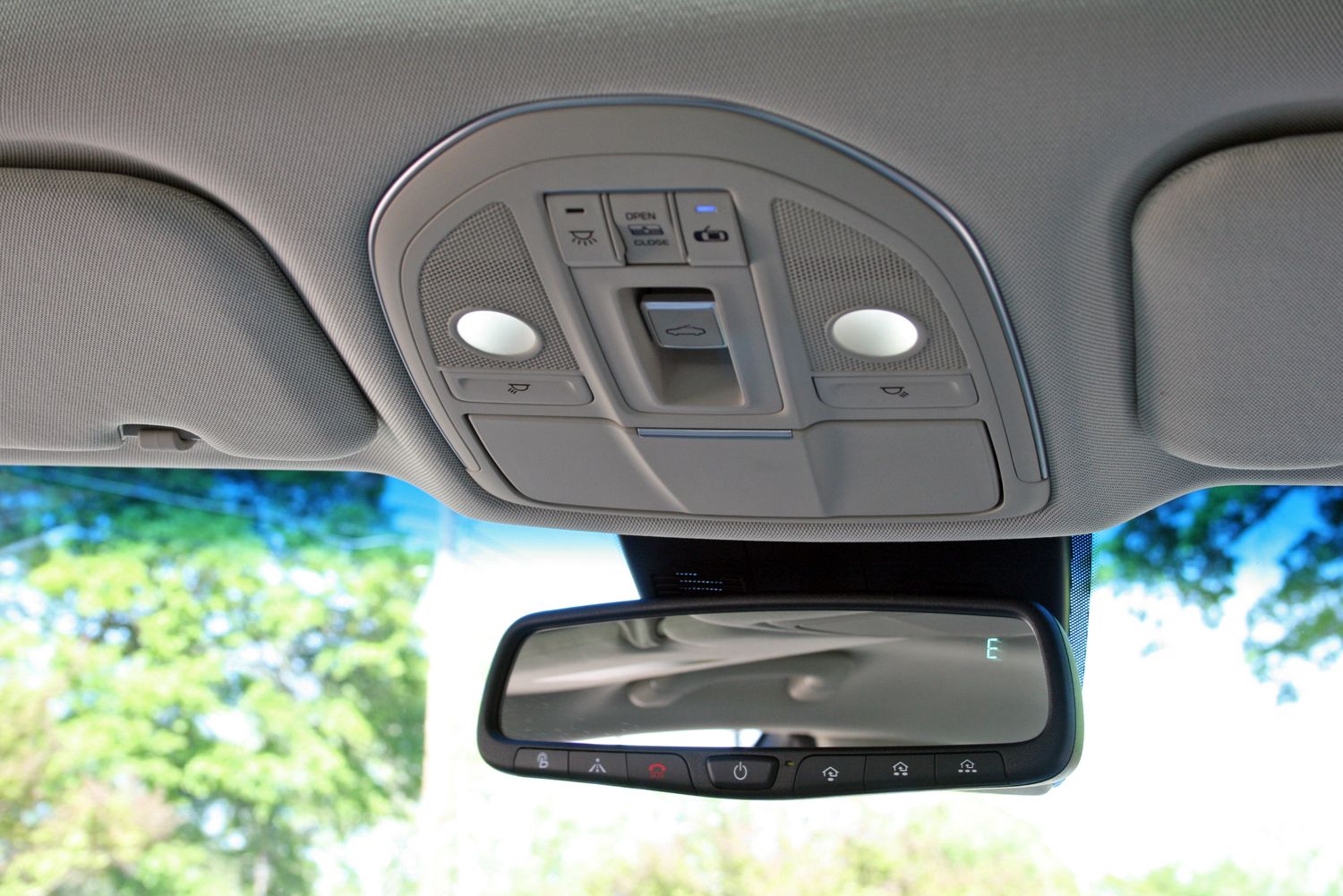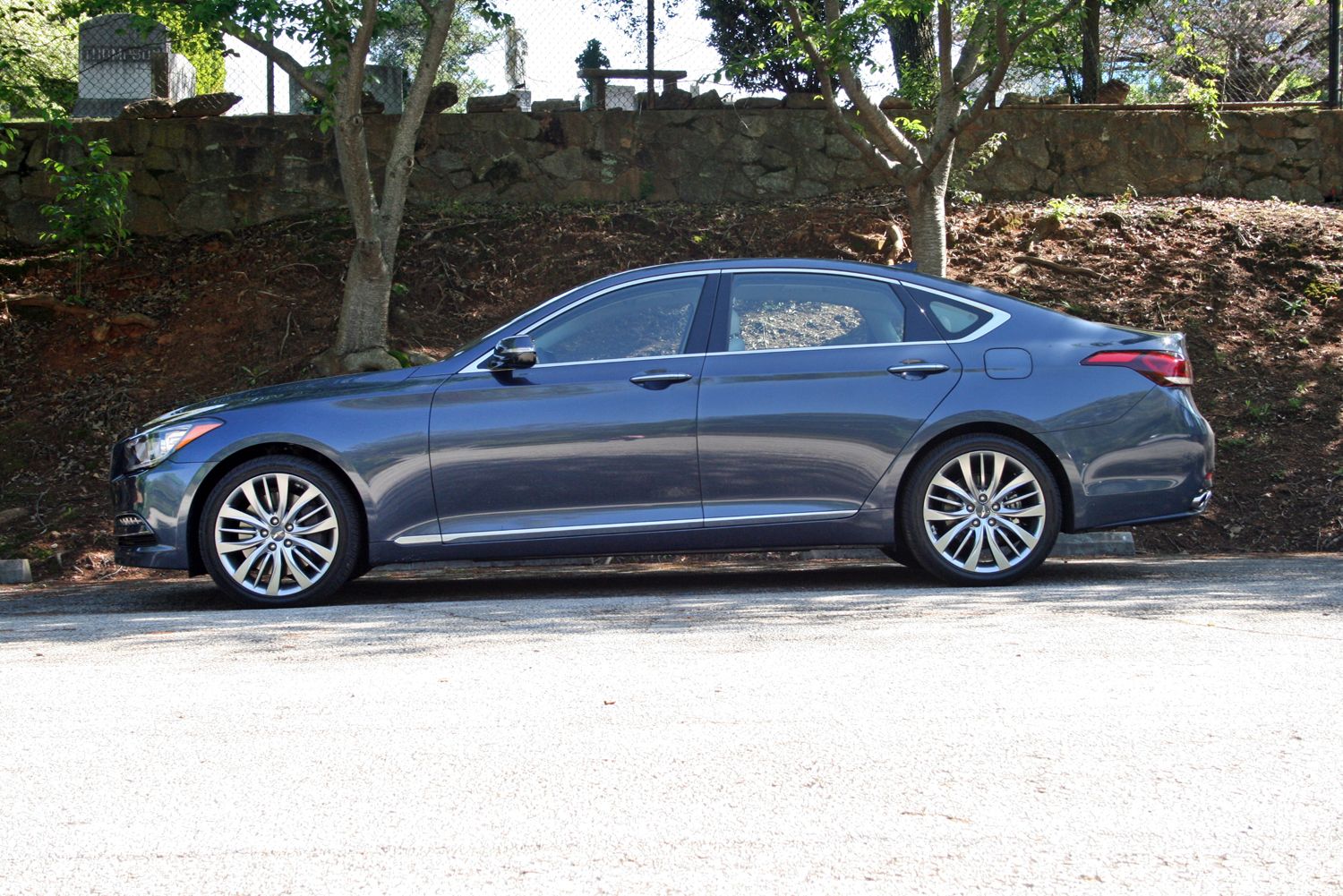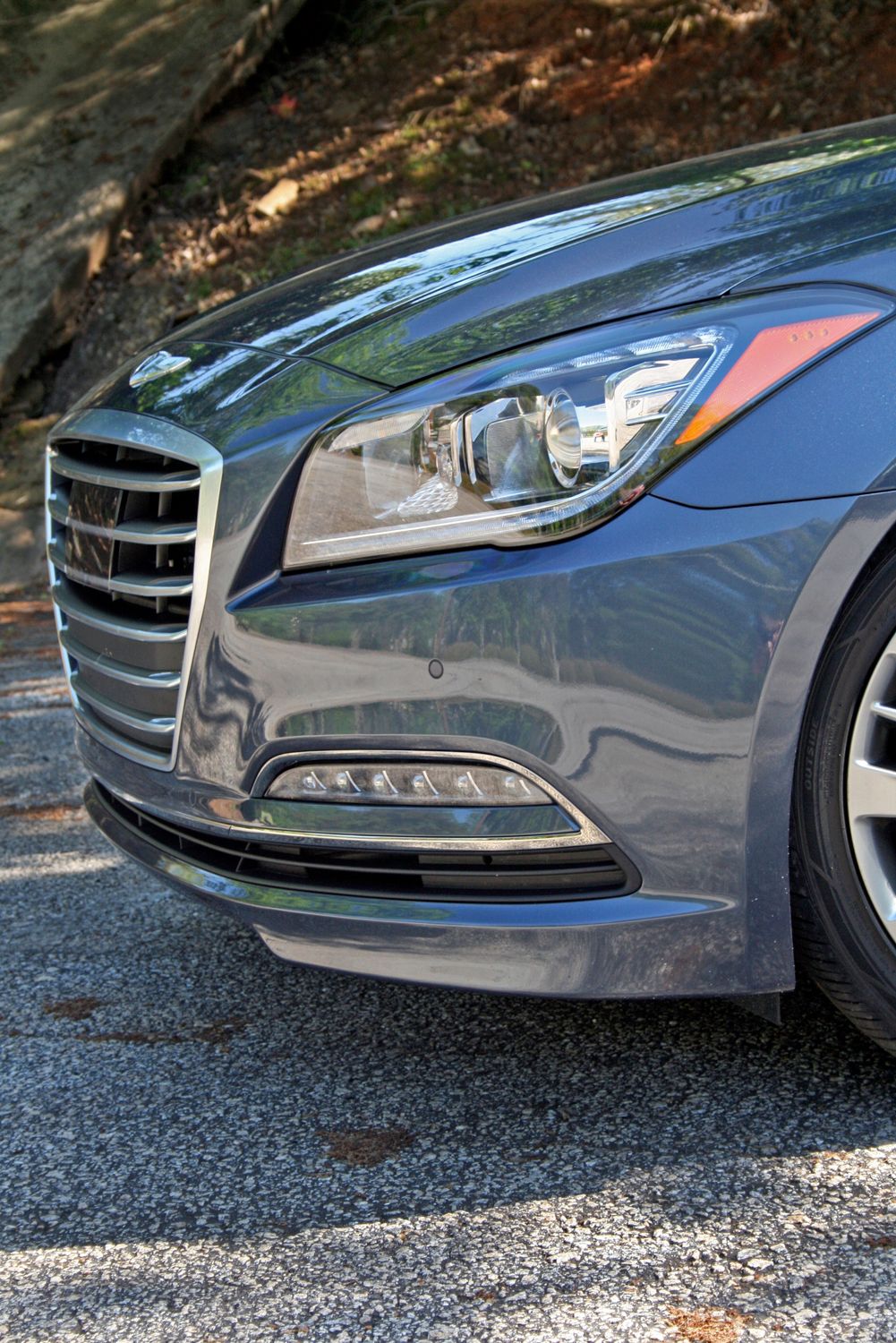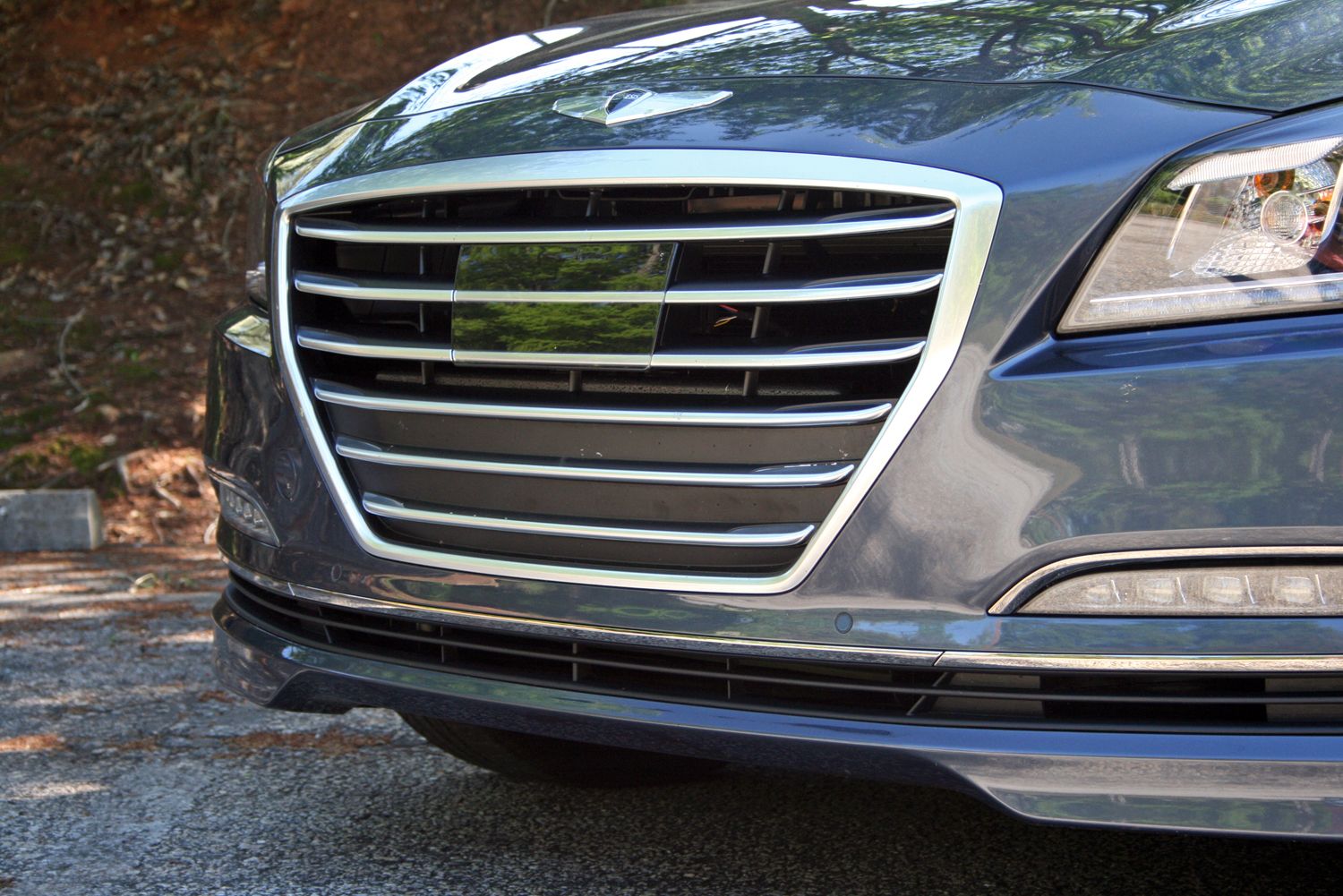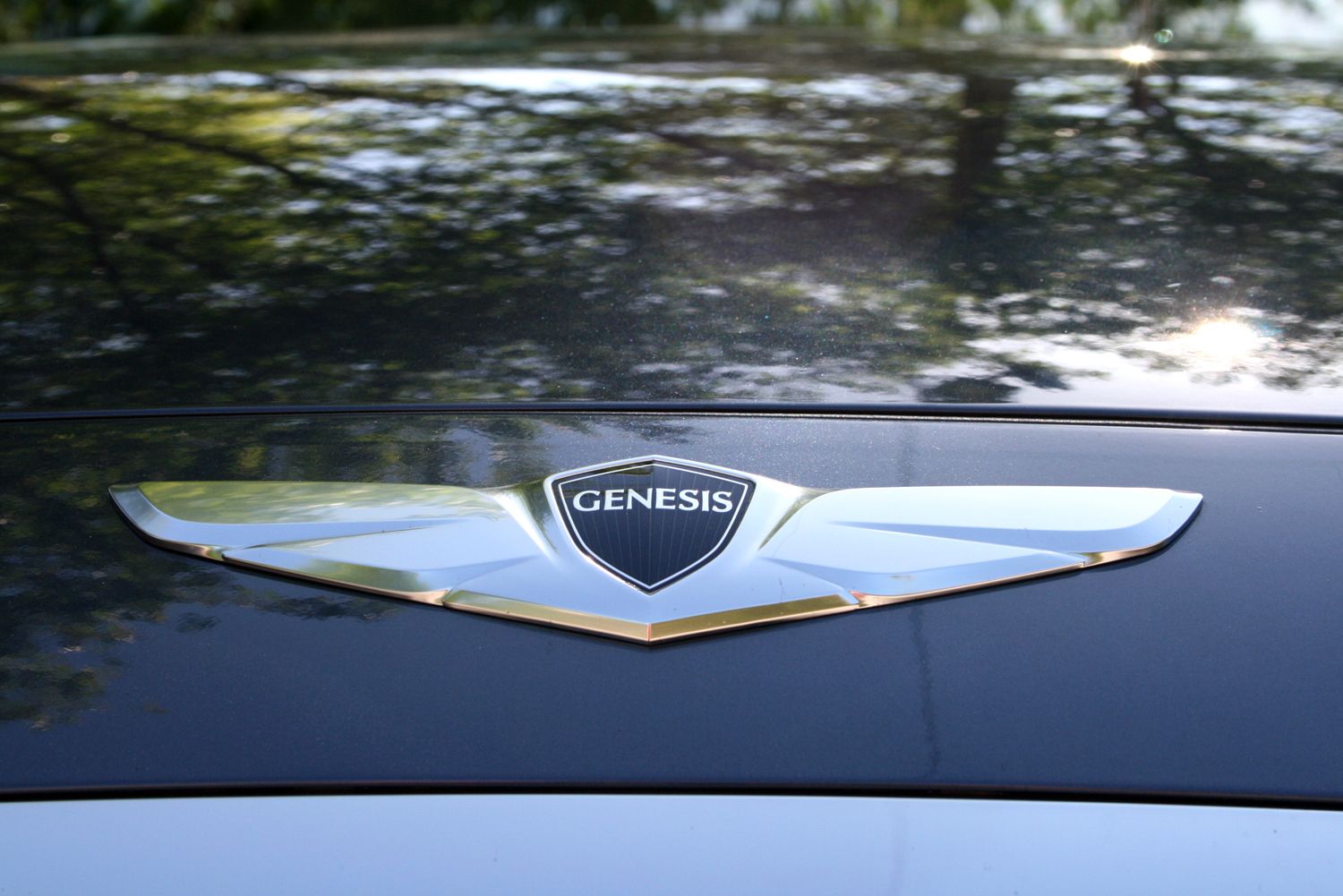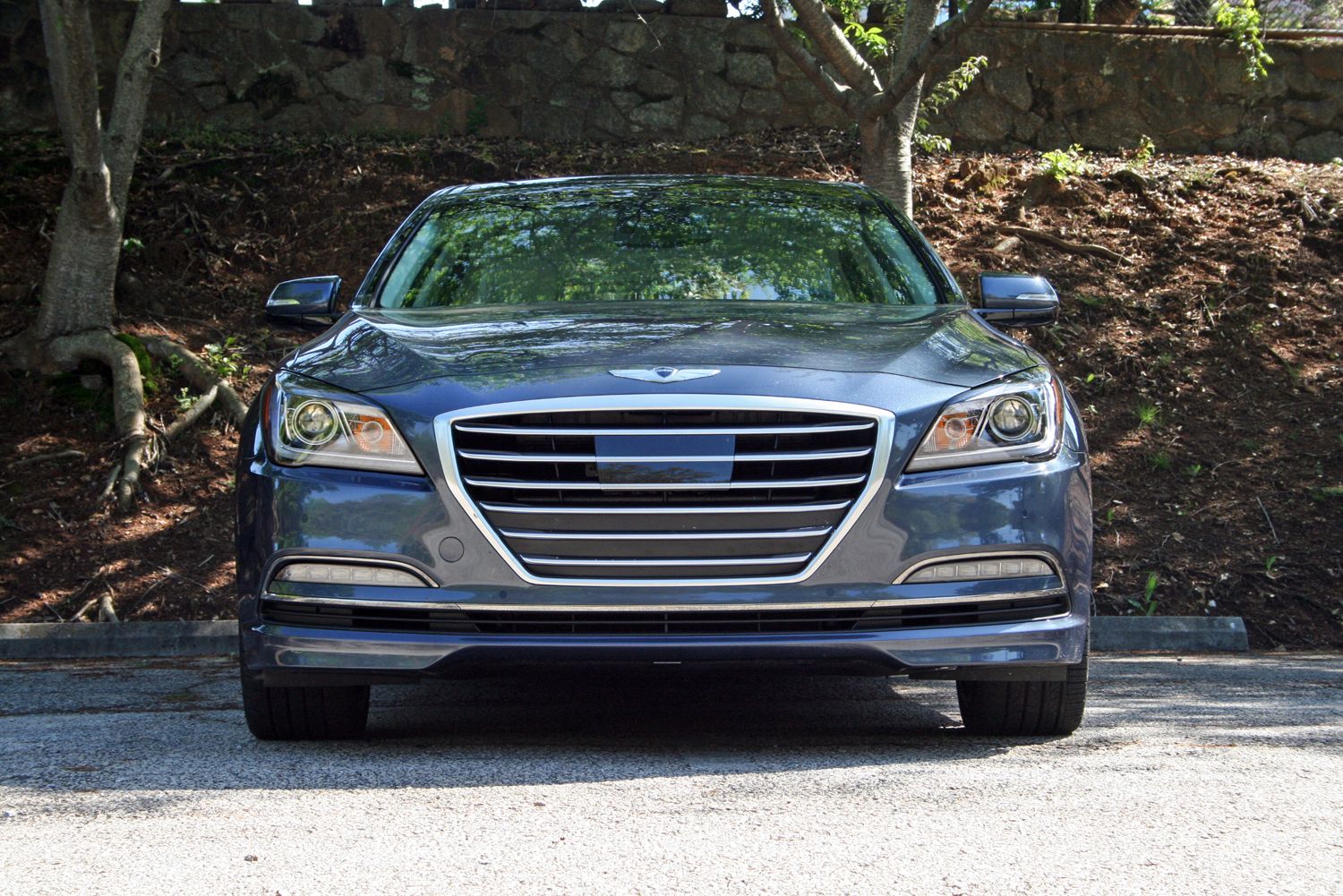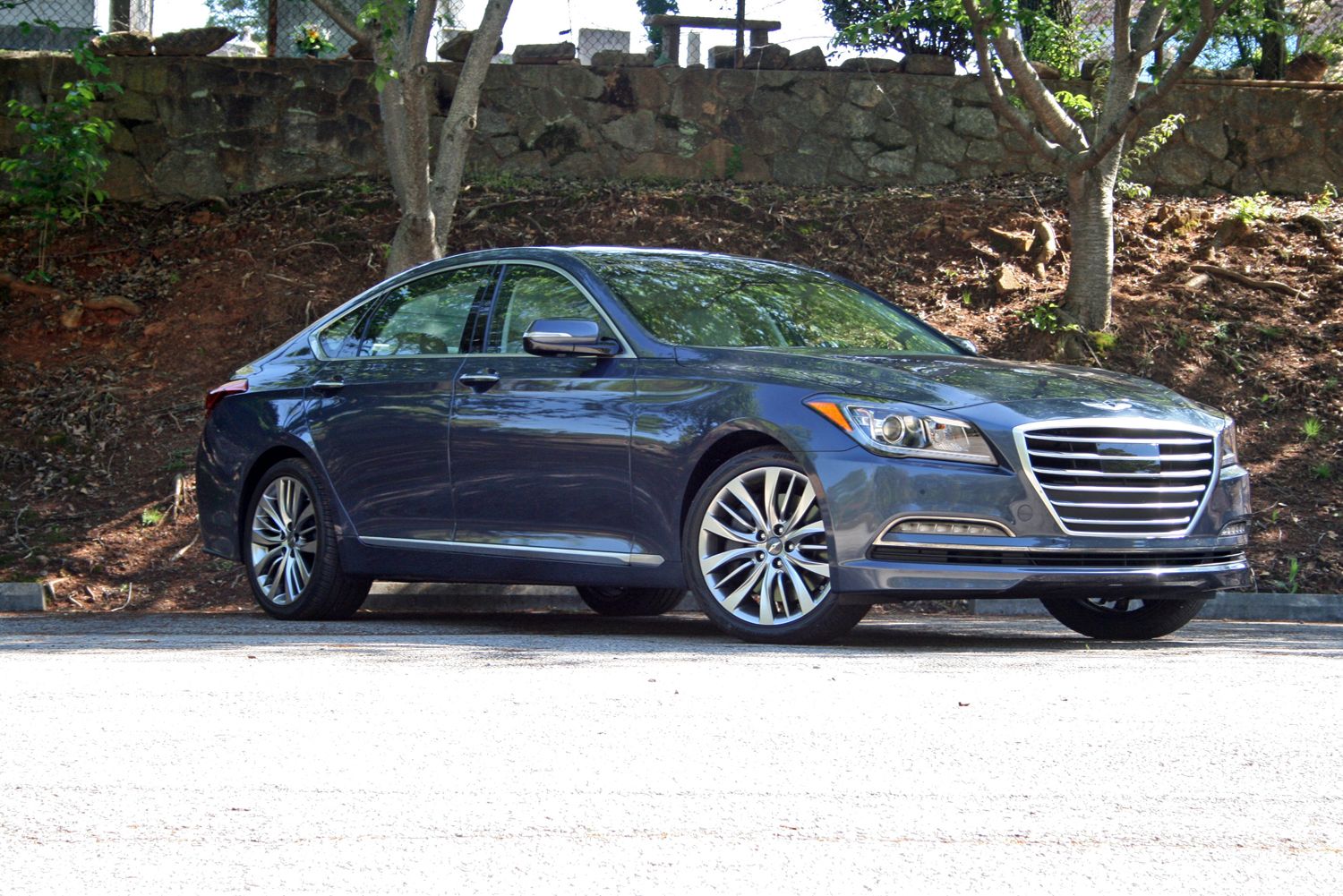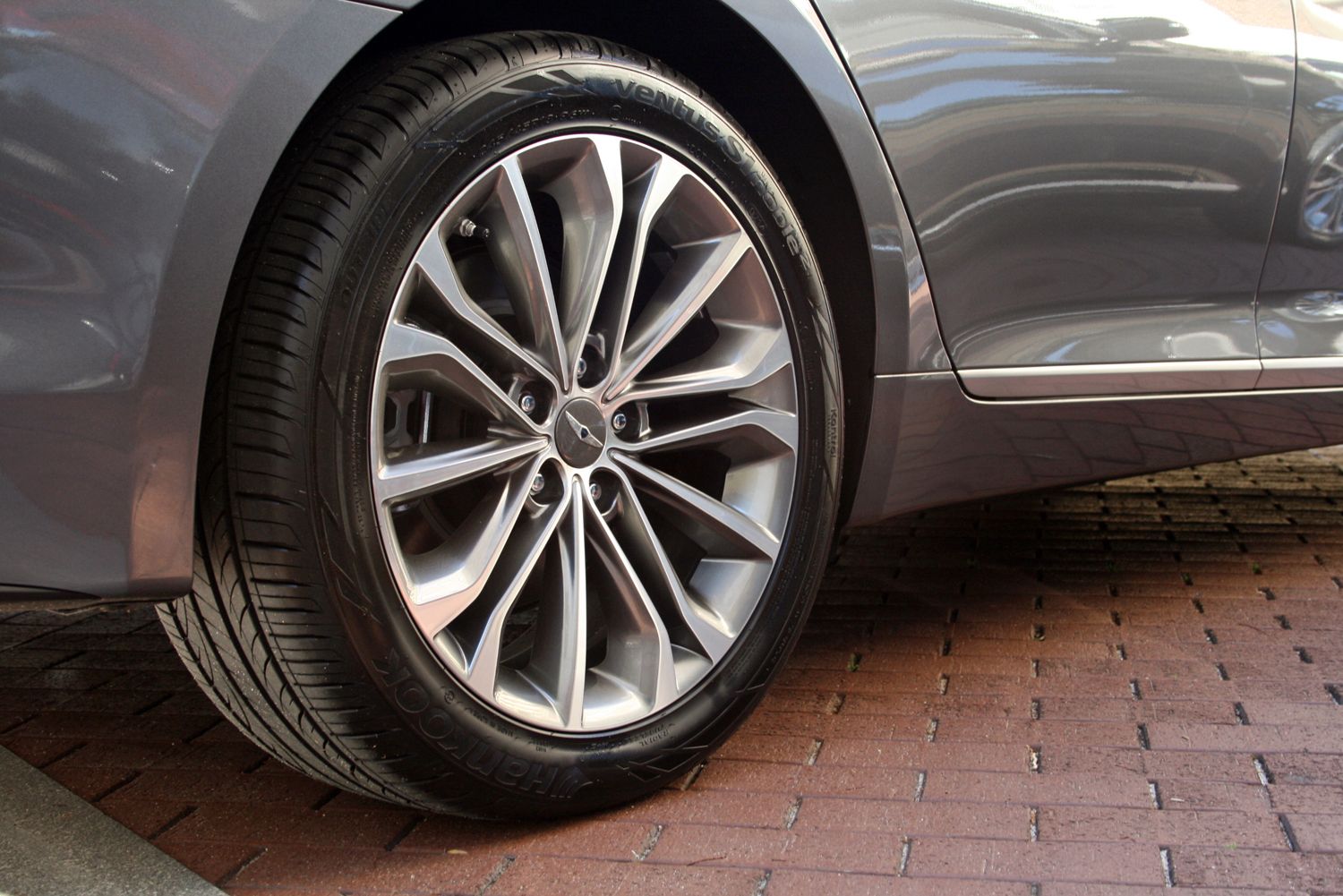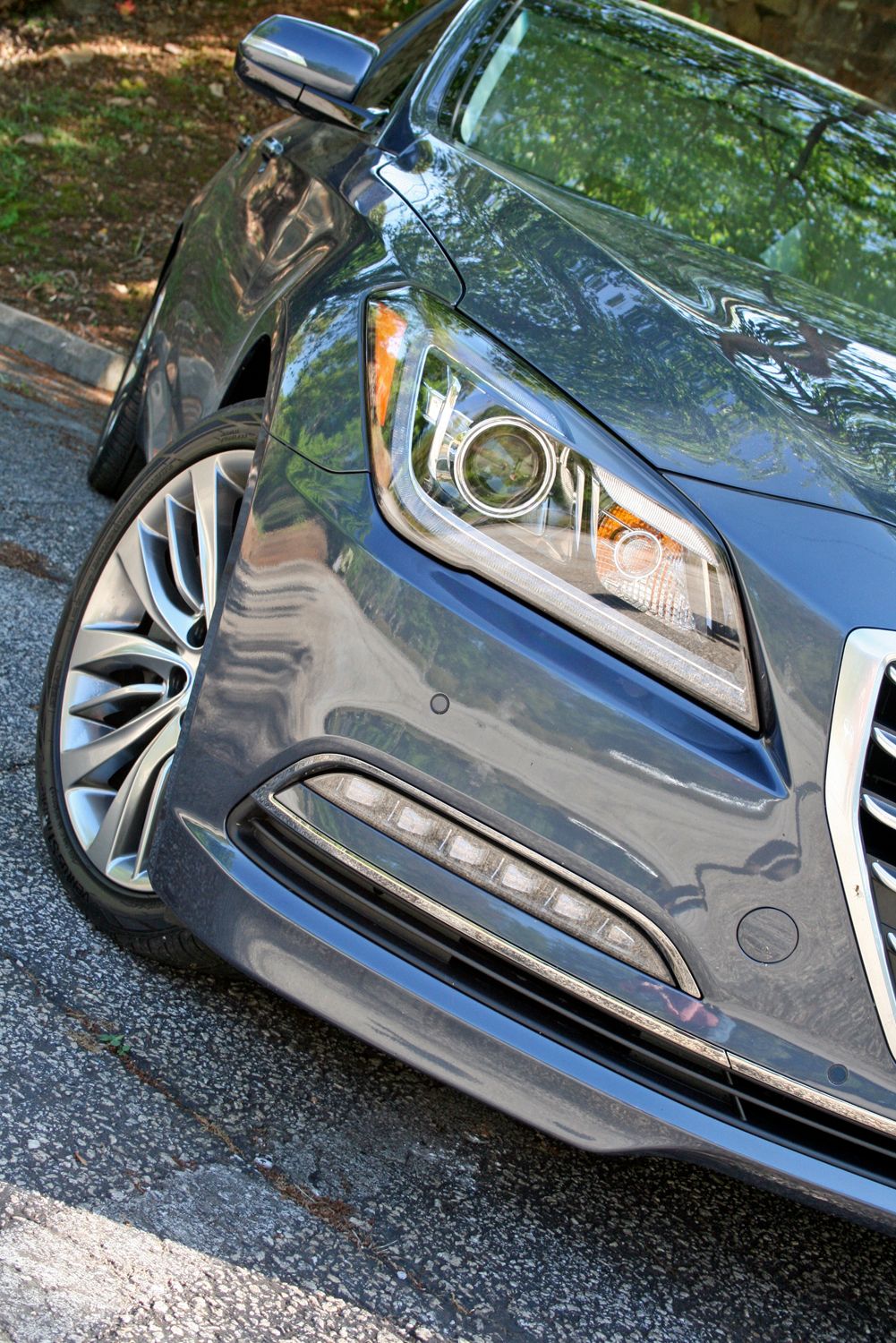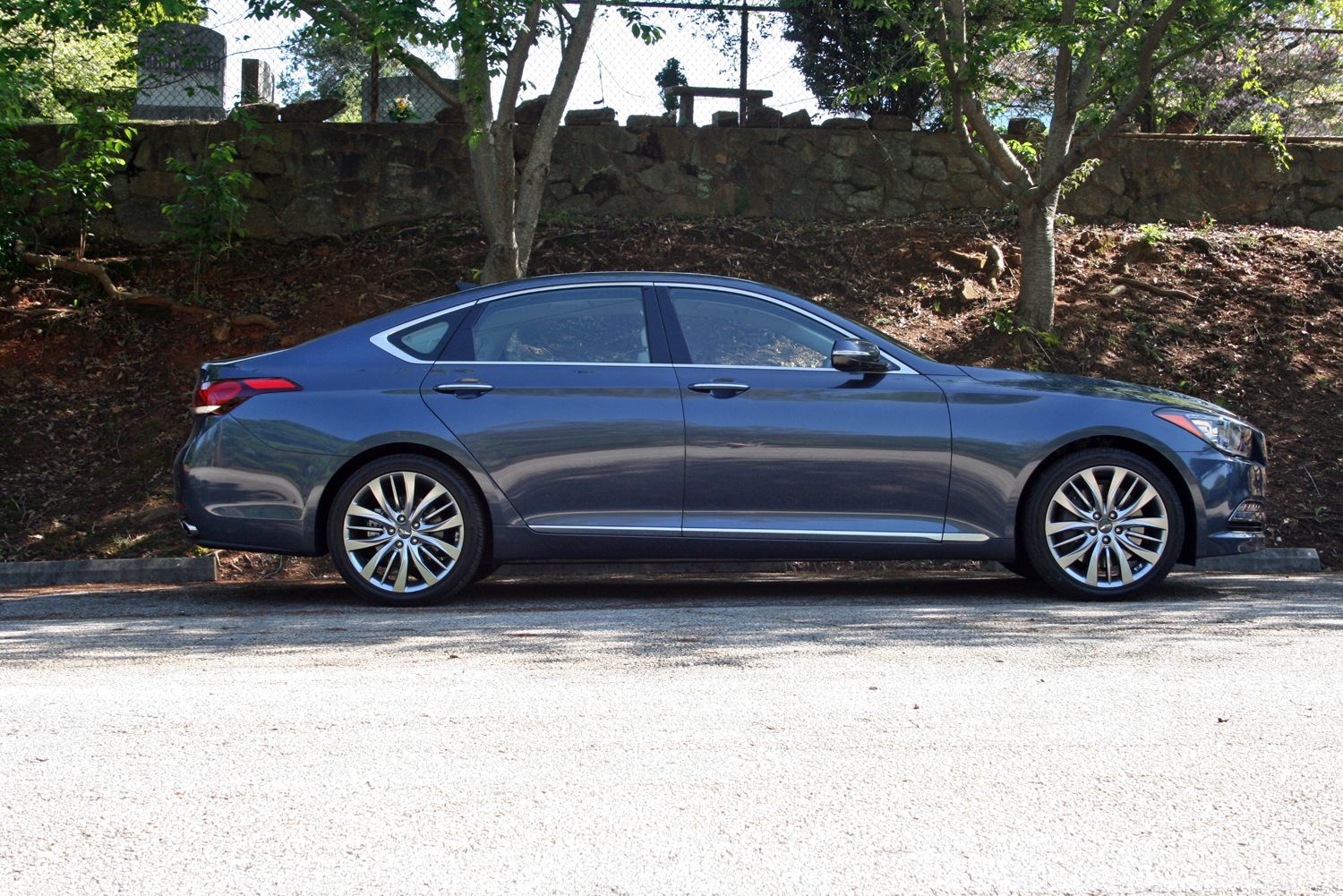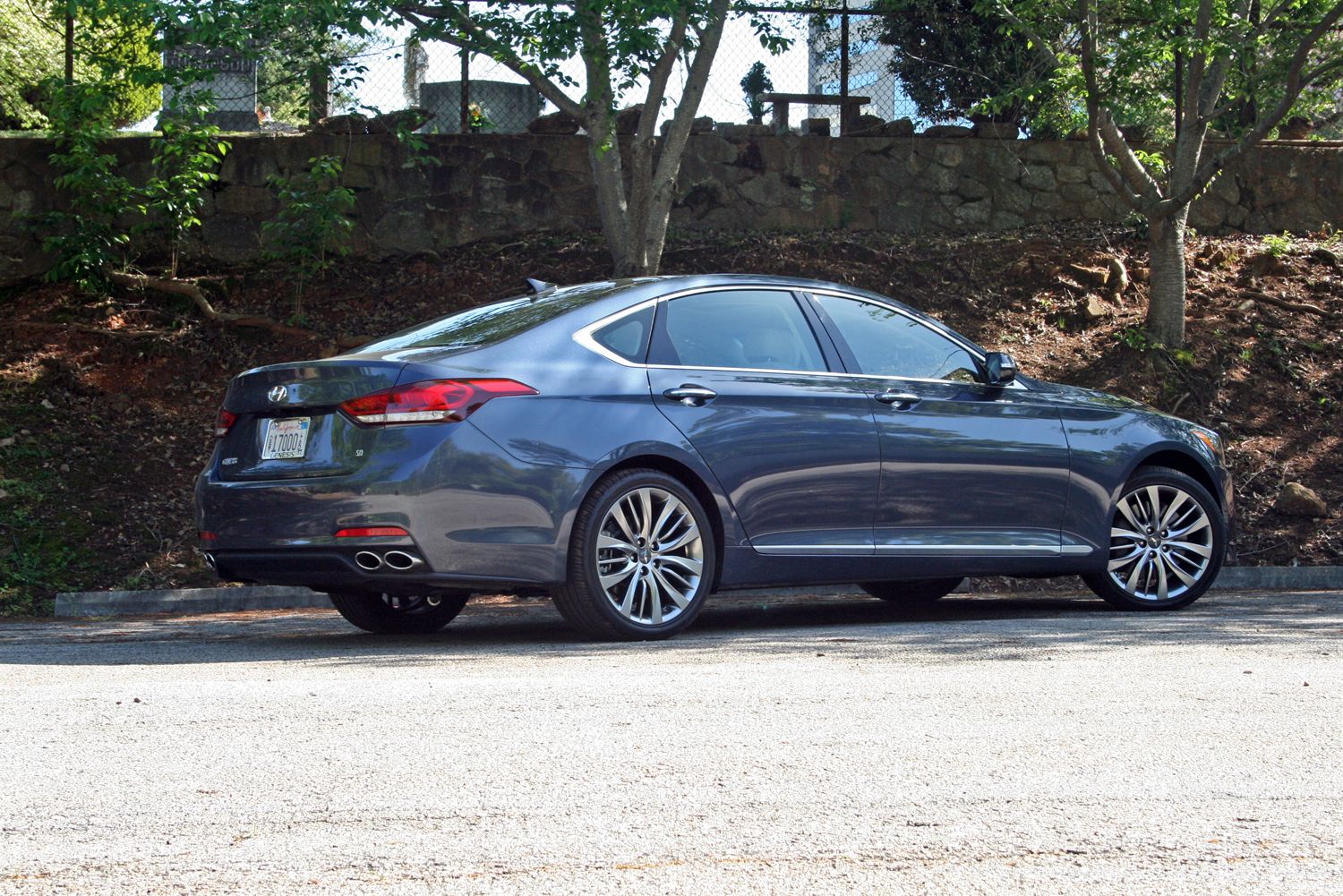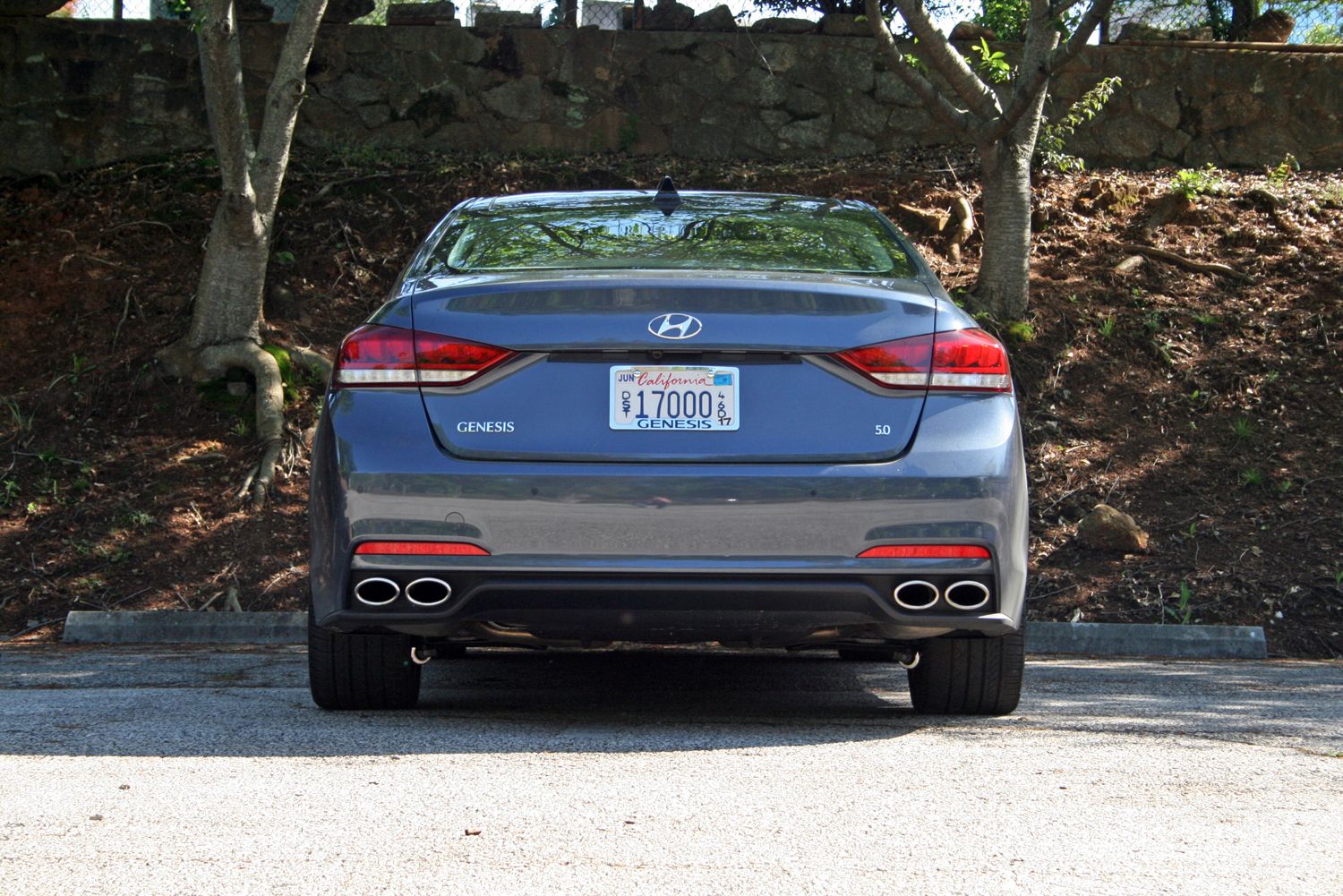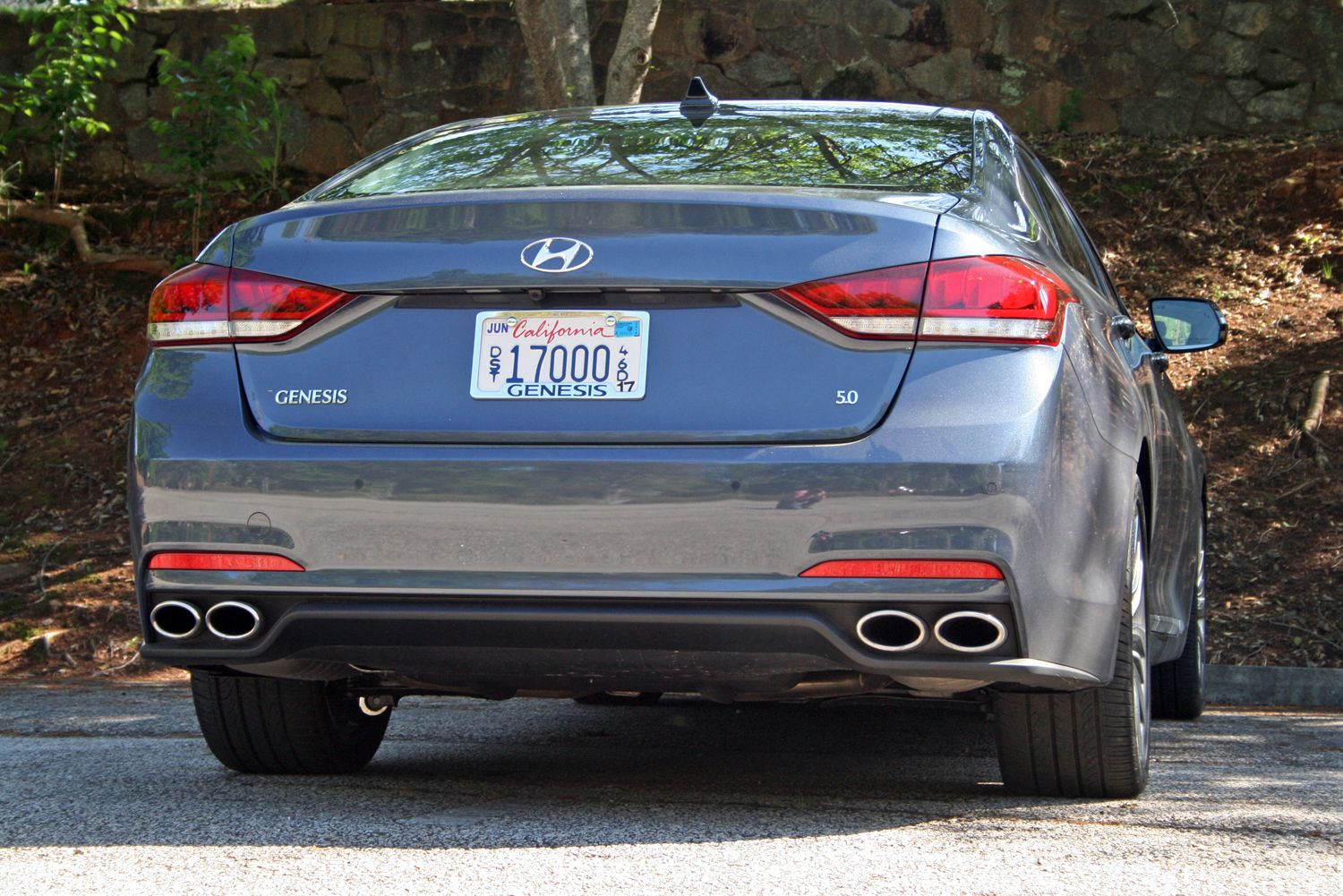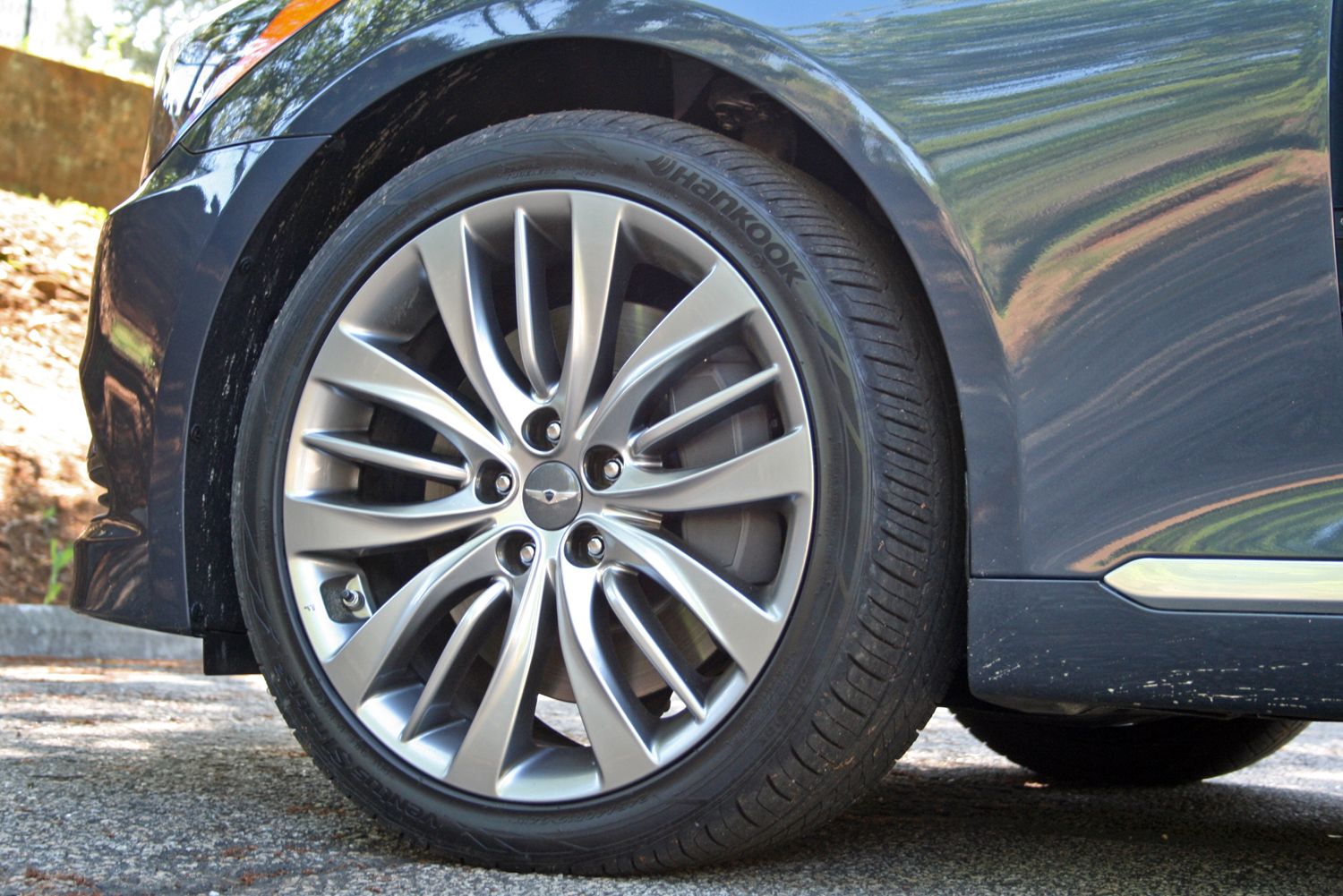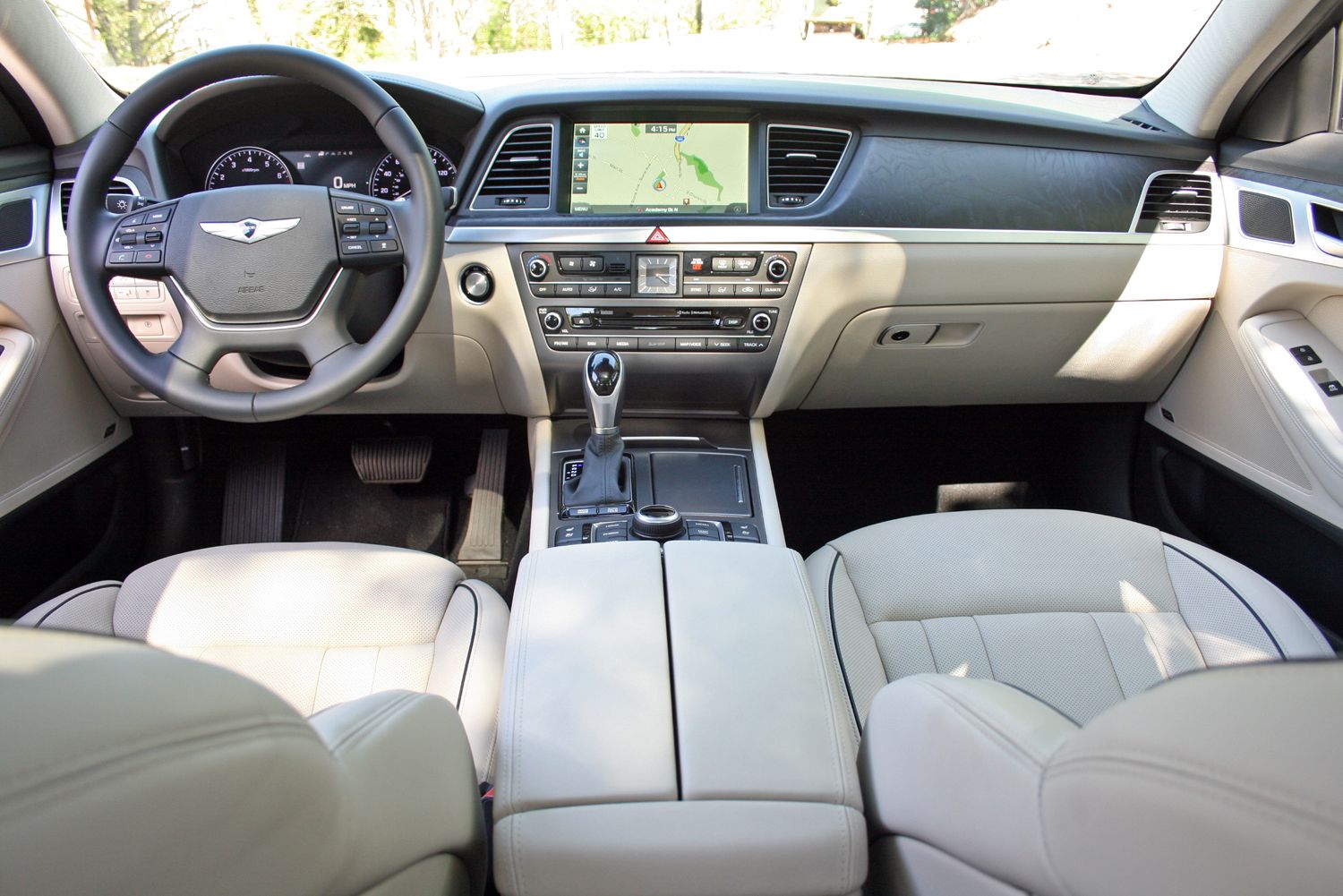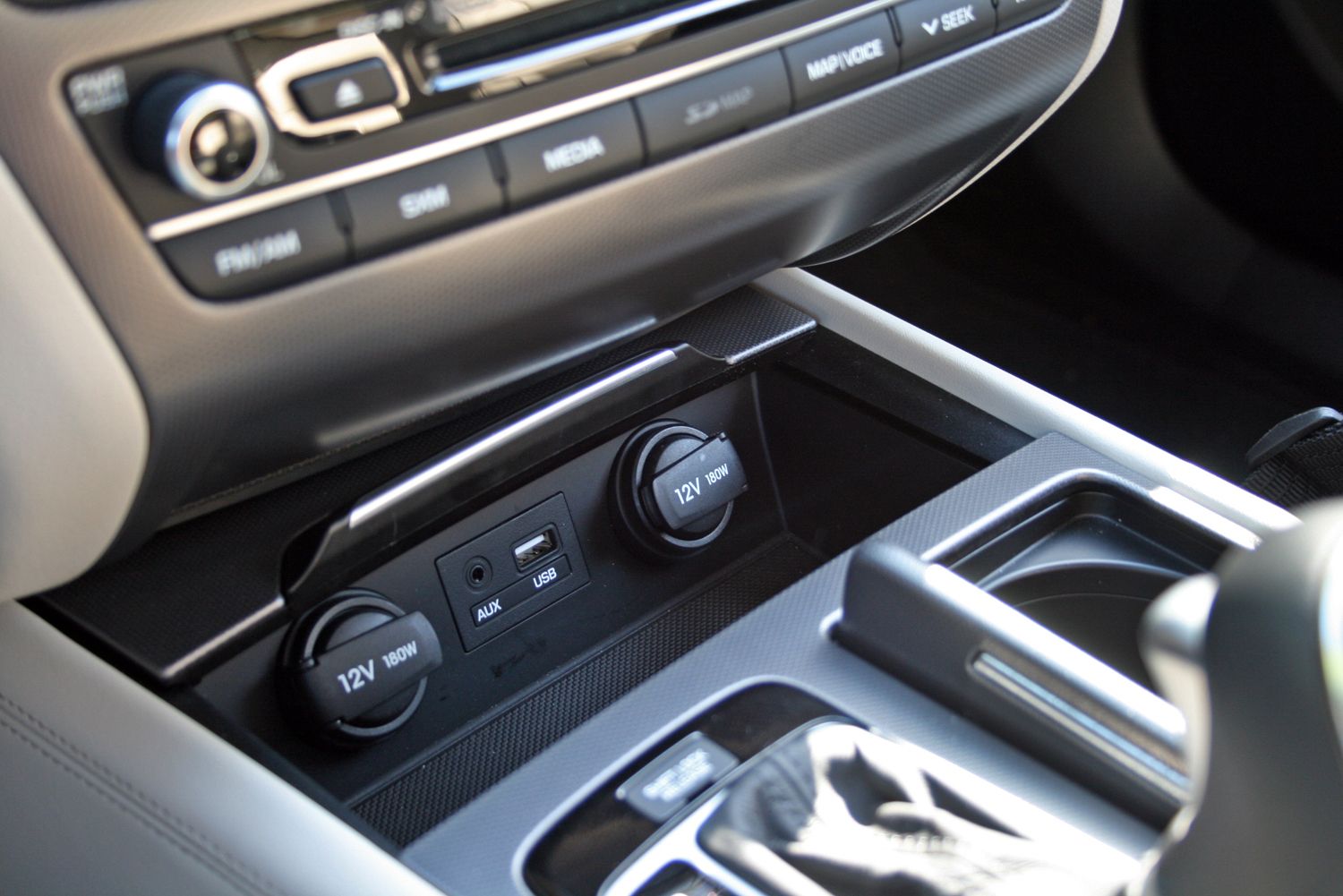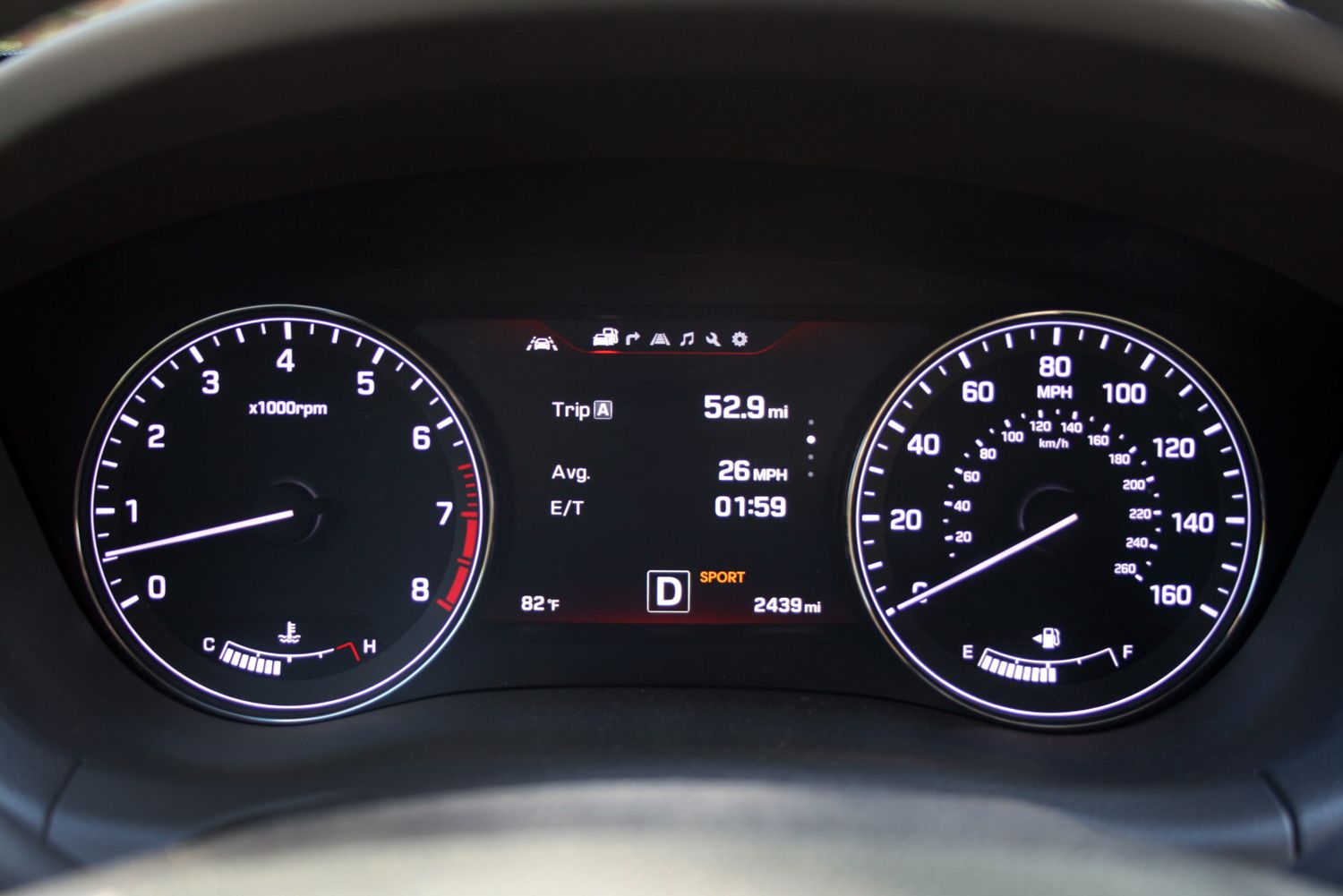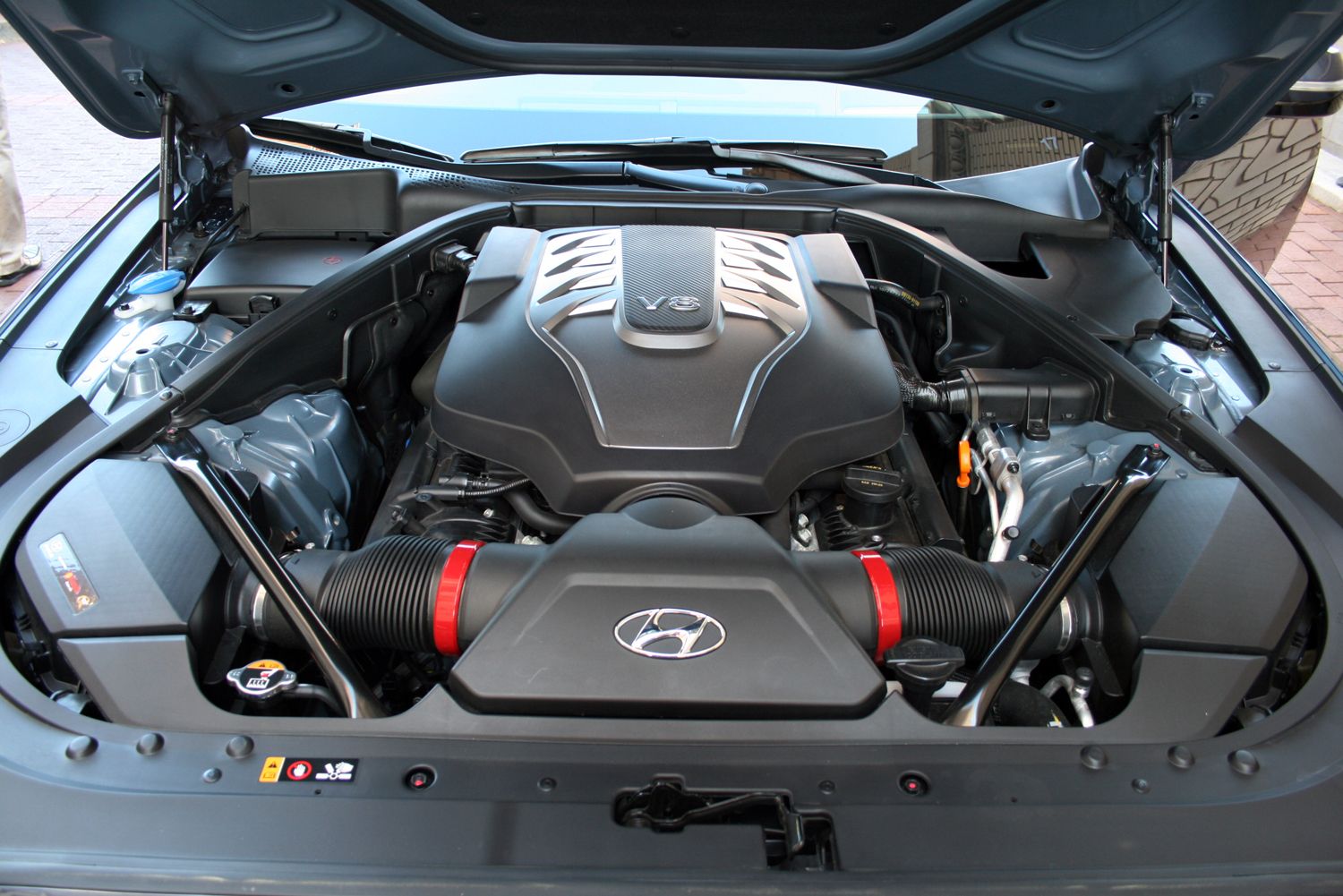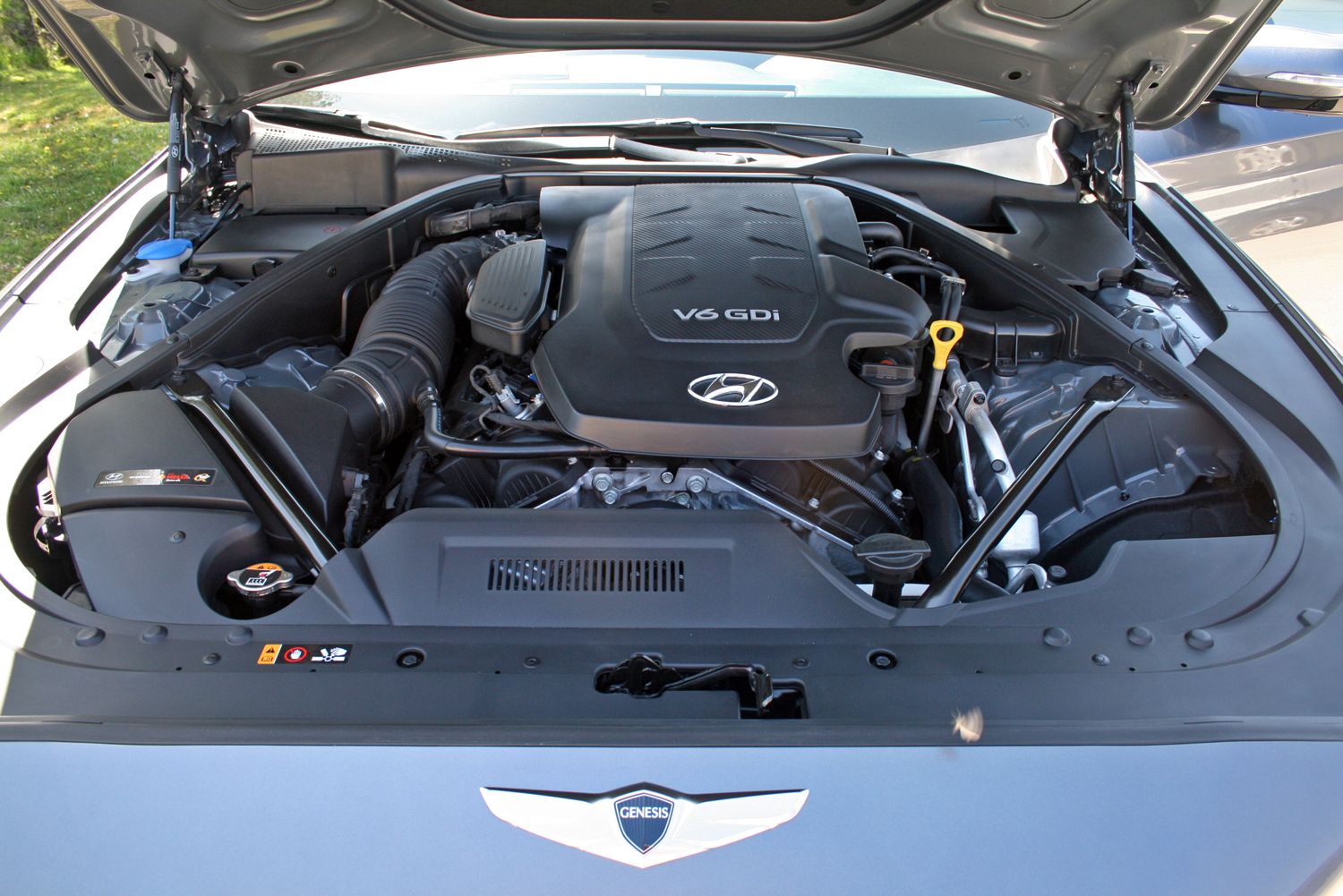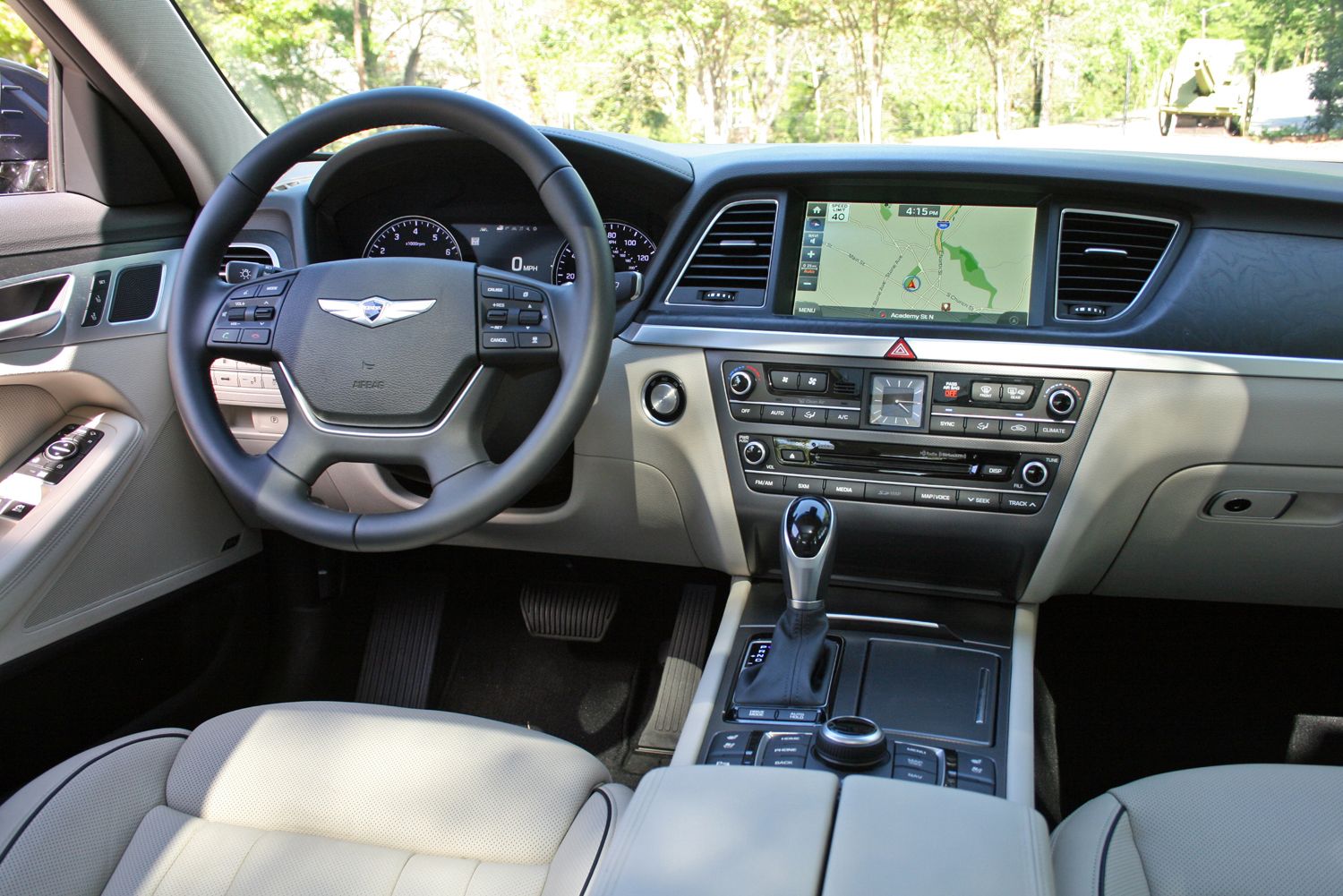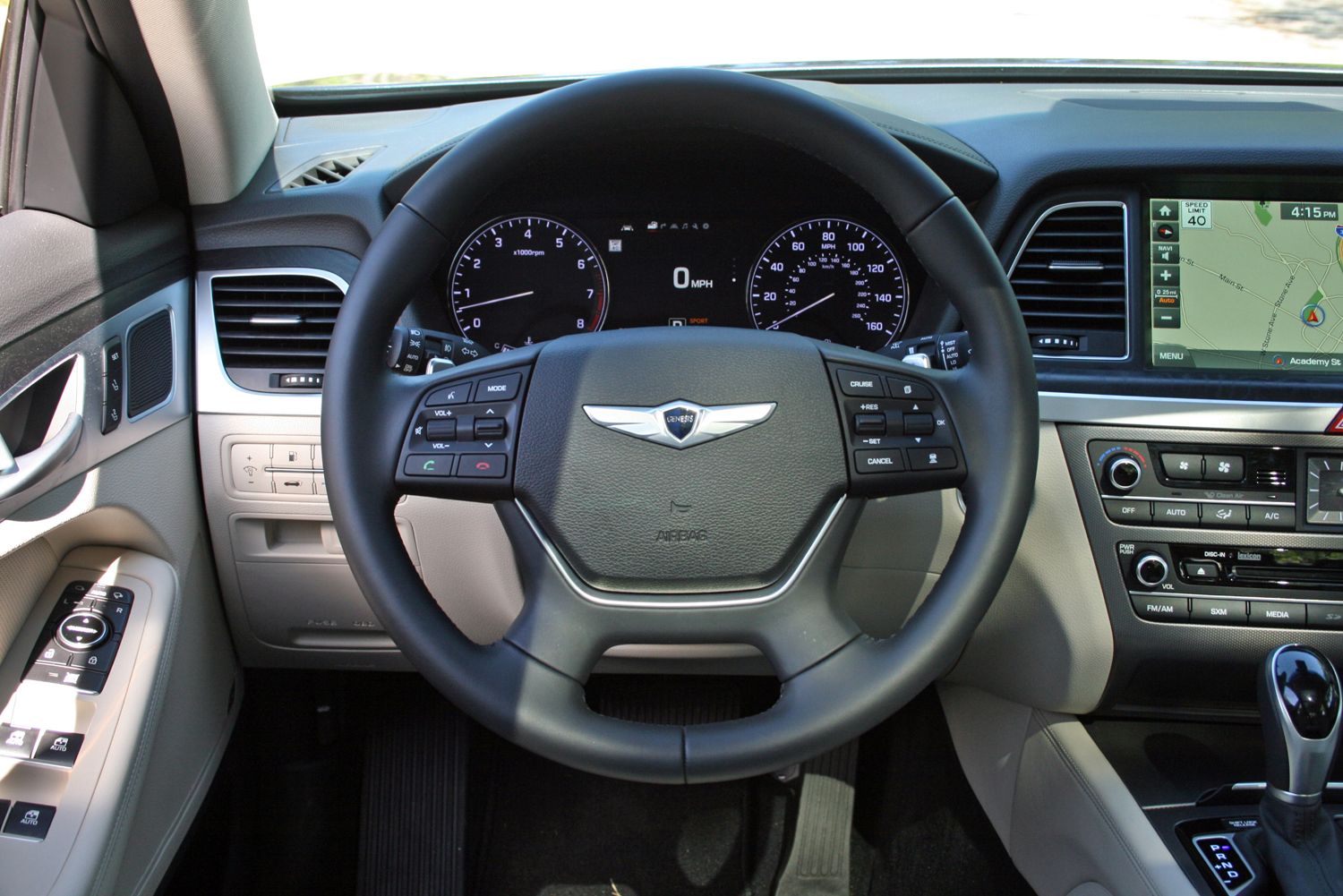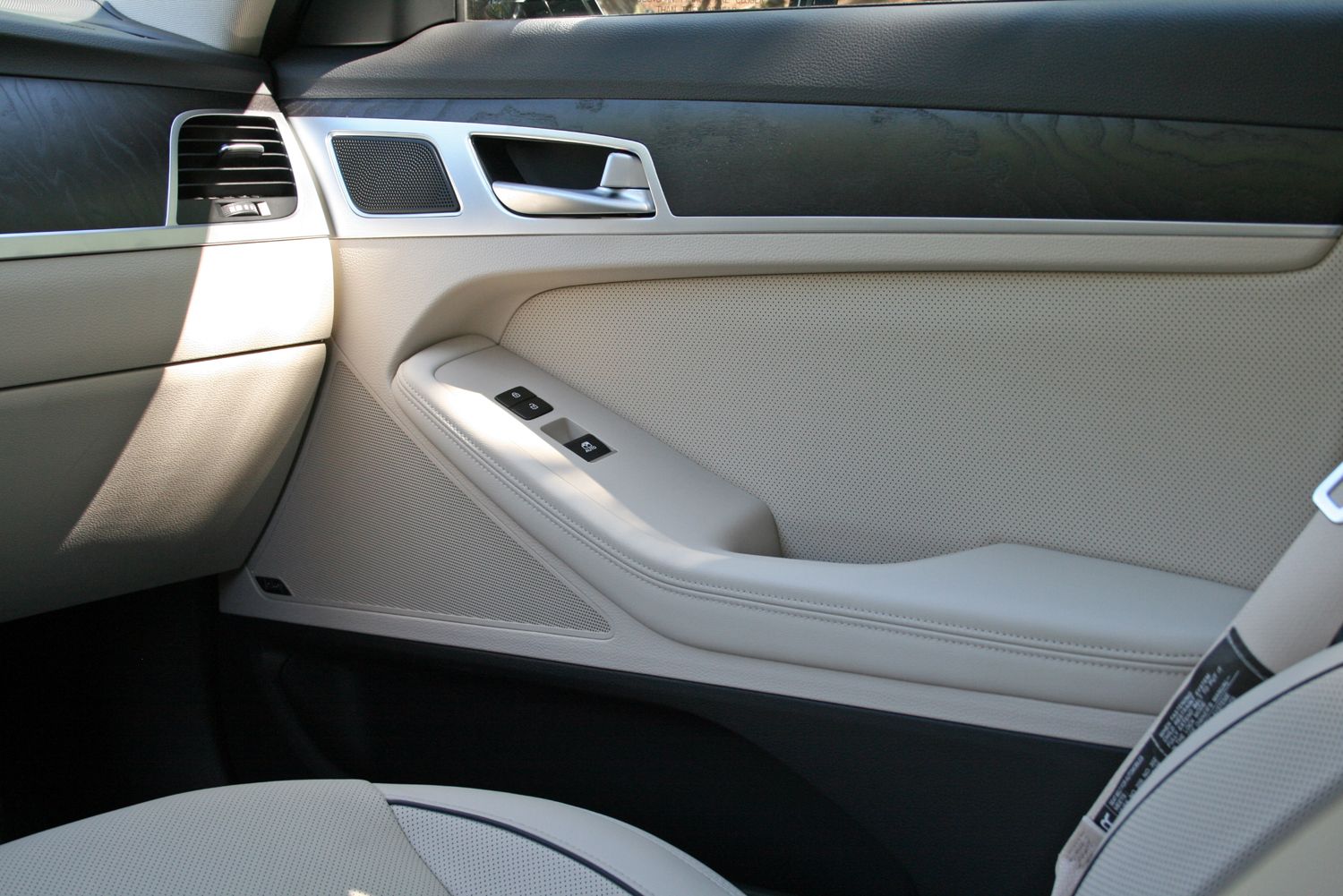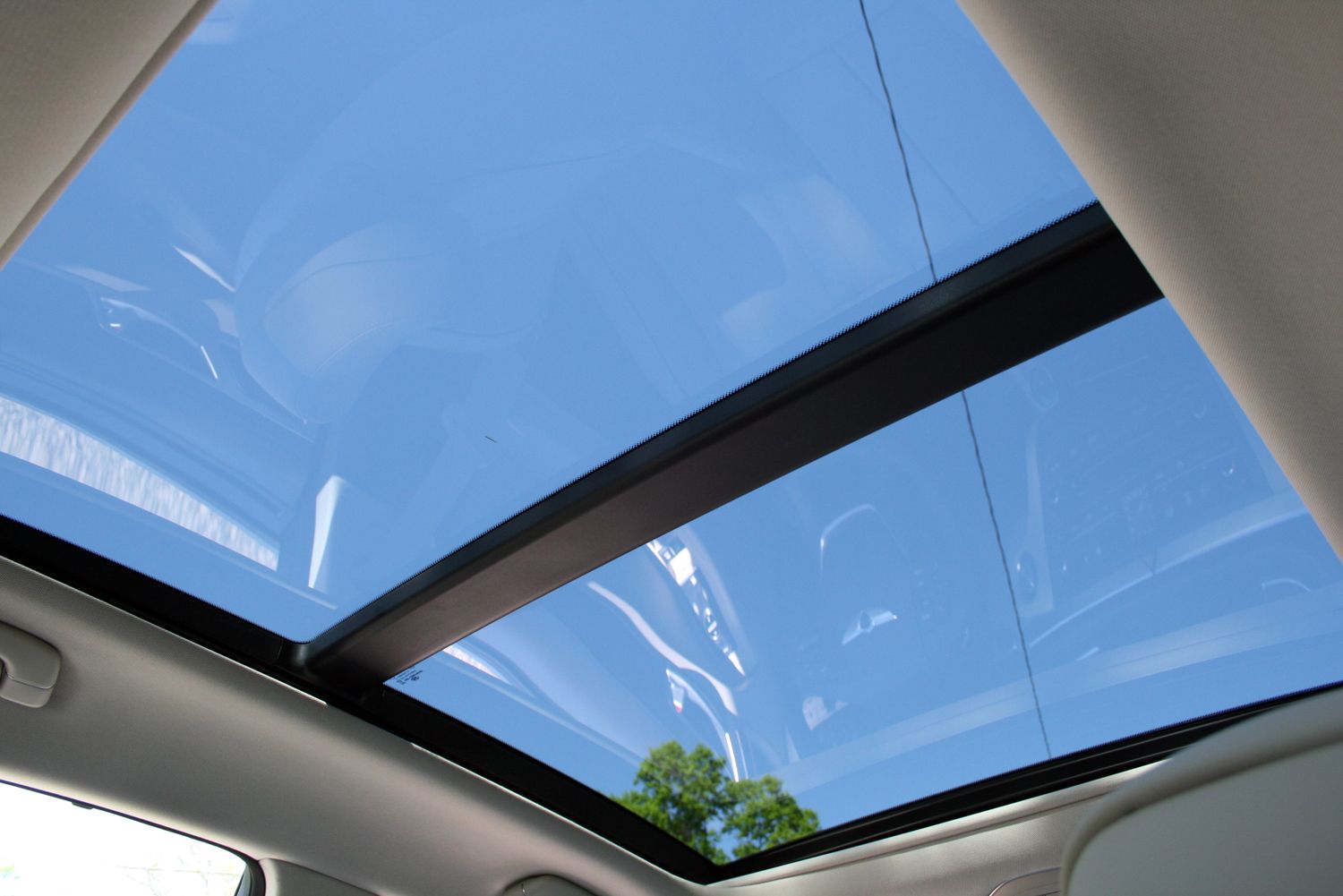Under the shadow of BMW’s->ke178 Spartanburg manufacturing plant nestled in the rolling hills of South Carolina, I found myself ripping through corners of back county highways in the new 2015 Hyundai Genesis. And though the plant only produces BMW’s popular SUVs and crossovers, the Genesis’->ke2924 intent to conquer giants became blatantly obvious the farther I traveled through the sweeping hills.
The roads along my path were littered with hairpin turns and switchbacks followed by long straights with varying pavement conditions. Besides the few locals traversing the trail and that one tractor creeping along behind a blind curve, the road was nearly mine. The Genesis’ new, more rigid chassis and upgraded suspension system with a driver-selectable Sport Mode rode tight with a very balanced feel that inspired confidence.
The steering in my RWD tester felt light yet properly weighted while its variable ratio kept my inputs in check. With the car weighing in at 4,138 pounds, I was amazed at how well the Hankook tires griped the road without howling complaints. Only under mid-corner power was I able to induce noticeable understeer. I’m no Mario Andretti, but I was giving it the beans. The Genesis just tracked like it was on rails with almost no body roll.
Click past the jump for the full report on the new 2015 Hyundai Genesis
2015 Hyundai Genesis - Driven
- Make: Array
- Model: 2015 Hyundai Genesis - Driven
- Horsepower: 311
- Torque: 293
- Transmission: 8-Speed Automatic
- [do not use] Vehicle Model: Array
I spent the majority of my time with the 3.8-liter V-6. Positioned as the volume engine below the mighty 5.0-liter V-8, I found the V-6 to be plenty potent for the mountain roads. Producing 311 horsepower and 293 pound-feet of torque, the naturally aspirated mill smoothly and quietly churns away up to its 6,000-rpm redline.
The standard 8-speed automatic comes equipped with paddle shifters that call up gears in a respectable time. Left in auto mode, the transmission does hesitate to downshift when matting the accelerator, but driving under eight tenths, the tranny works fine, providing silky-smooth shifts around town and cruising down the interstate.
Once on the highway and my heart rate had dropped, I set the Smart Cruise control system at the speed limit and settled in. As the system kept me a paced behind the car in front of me, I began to take stock of the interior’s amenities.
Interior
My hands griped a thick-rim, leather-covered steering wheel with multifunction controls and paddle shifters adorning it like jewelry. Behind the wheel sat a 7-inch TFT display that kept the Genesis’ critical information front and center. Flanking that were two large analog gauges with a white-on-black color scheme. The font was easy to read and the detailing within the bezels made for a premium feel. To my right lay a massive 9.2-inch infotainment screen with full 720p high definition capability. The menu pages and settings were easy to find and simple to navigate. Voice commands made things even easier. What’s more, the system includes voice command searching powered by Google. Its results come directly from the search engine, so the info is fresh.
Controlling the infotainment system on cars equipped with the Ultimate Package is a rotary dial with a myriad of buttons surrounding it perched between the gear selector and center armrest. Using the dial was very intuitive and didn’t require taking my eyes off the road. Overall the ergonomics are phenomenal, save for one issue. I kept changing radio stations with my palm when parking or as I maneuvered the car around tight corners that required several turns of the wheel. After a few times, I learned to adjust my hand to avoid the problem.
I found the cabin a wonderful place to spend time. The leather seats are generously padded and nicely bolstered. Even after a day of driving, they hadn’t lost their comfort. A tilting/telescoping steering wheel made getting comfortable easy and the armrests proved perfectly padded and on equal heights, avoiding the shoulder slouch induced in some cars. Real wood and aluminum trim pieces dress up the environment of the cabin while its overall fit and finish is superb.
The back seat offers tons of room with ample leg, hip, shoulder, and headroom. Even sitting behind a taller person, the Genesis still had room to spare for my smallish size-nine shoes. The rear bench offers a folding center armrest with a trunk pass-through for hauling longer objects like rugs and skis while front center armrest houses two HVAC vents for the rear passengers.
Speaking of the HVAC system, Hyundai engineers figured out that one of the main reasons folks inside a car get drowsy after a long period of time is an increase in CO2 levels within the cabin. To combat this effect, the engineers devised a sensor that detects higher levels of CO2 and automatically pulls in fresh outside air.
2015 Hyundai Genesis - Interior Dimensions
|
Head room (in., front/rear) (w/ sunroof) |
41.1 / 38.2 (39.4 / 38.2) |
|
Legroom (in., front/rear) |
45.7 / 35.0 |
|
Shoulder room (in., front/rear) |
58.3 / 57.1 |
|
Hip room (in., front/rear) |
55.7 / 54.8 |
|
Total interior volume (cu. ft.) |
123 |
|
Passenger volume (cu. ft.) |
107.7 |
|
Cargo volume (cu. ft.) |
15.3 |
Exterior
The winding mountain roads had led me up from Greenville into Hendersonville, North Carolina where lunch was waiting at the Flat Rock Wood Room, a world-class barbeque restaurant just outside of town. After stuffing my face with the most amazing full rack of dry-rub ribs smothered in the best barbeque sauce I’d ever had, I was struck by just how good-looking the new Genesis is as I walked outside.
Its long, sloping nose falls towards the unique slotted grille and HID headlights with LED daytime running lights. The strong accent line that runs from above the headlights, through the door handles, and into the rear taillights casts a nice shadow on the lower portion of the car when parked under the mid-day sun. The lower indentation running along the door bottoms make the Genesis appear to be sucking in its gut, giving it a lighter look -- something I, too, was doing after that lunch.
Around back, two different styles of exhaust pipes help distinguish the engine options apart. The 3.8-liter V-6 comes with rectangular chrome pieces; one on each side, while the 5.0-liter V-8 gets four oval-shaped tips.
2015 Hyundai Genesis - Exterior Dimensions
|
Trim |
3.8 |
5.0 |
|
Wheelbase (in.) |
118.5 |
118.5 |
|
Length (in.) |
196.5 |
196.5 |
|
Width (excludes mirrors) (in.) |
74.4 |
74.4 |
|
Height (in.) |
58.3 |
58.3 |
|
Track (in., front/rear) |
64.1 / 65.3 |
63.8 / 64.3 |
|
Curb weight (lbs.) |
4,138 (RWD) / 4,295 (AWD) |
4,541 |
Drivetrain
Sliding back into the car after lunch, I embarked again on a seemingly endless and heavily curved highway. This time I had swapped for an AWD example still powered by the V-6. The steering is the most noticeable difference between the cars, with the AWD offering a much heavier feel. I preferred the more natural feeling steering in the RWD car, but the extra grip came in handy when exiting corners under power. The grip was tremendous.
Engaged in Sport Mode, the AWD HTRAC system sets itself up for more fun with a 10/90 – front/rear torque split. While the system works well for summertime cornering, it also greatly extends the Genesis’ all-weather abilities. If slip is detected, a 90/10 torque split can be achieved to help pull the car through a snowy or icy situation. Once the weather turn cooperative and the driver isn’t flogging it the car up a mountain pass, the system defaults to a 40/60 split. For fuel savings, an Eco mode is available to turn the system completely off for a 0/100 torque split.
Though the AWD system is all-new, the two engine options are carryover from 2014. The standard 3.8-liter V-6 has been highly massaged for better drivability and a stronger power delivery under 4,000 rpm. In order to achieve this, Hyundai engineers lowered the engine’s redline by 400 rpm to 6,000 and flattened its low-to mid-range torque band. A new intake manifold was added, the variable valve timing was reprogrammed, new fuel injectors added, piston coatings applied, and a variable-pressure oil pump bolted on. The changes give the V-6 one pound-foot of torque more than last year, but decrease the horsepower by 22. That’s mainly due to the lowered redline and reworked mid-range torque curve, but engineers say the 22 ponies won’t be missed because more power is available in a more usable rpm range.
2015 Hyundai Genesis - Drivetrain Specifications
|
Engine |
3.8-Liter |
5.0-Liter |
|
Type |
V-6 |
V-8 |
|
Horsepower @ RPM |
311 @ 6,000 |
420 @ 6,000 |
|
Torque (LB.-FT. @ RPM) |
293 @ 5,000 |
383 @ 5,000 |
|
Transmission |
8-Speed Shiftronic |
8-Speed Shiftronic |
|
City/highway/combined (RWD) |
18 / 29 / 22 |
15 / 23 / 18 |
|
City/highway/combined (AWD) |
16 / 25 / 19 |
Not Available |
The 5.0-liter V-8 is also a carried over, though it received some minor updates as well. A lower-friction crankshaft seal and redesigned timing chain help increase the engine’s efficiency. All told, the powertrain delivers 420 horsepower and 383 pound-feet of torque.
Having driven both, I can say the V-8 is a sweetheart with loads of passing power and a meaner exhaust note, but the V-6 is plenty powerful for 98 percent of the driving anyone will ever do with a Genesis. The V-6 is lighter and makes the car less nose-heavy, therefore helping the overall balance. Its fuel economy numbers are more respectable, coming in at 18/29/22 mpg on the city, highway, and combined loop. Adding the AWD system to the V-6 drops those numbers slightly to 16/25/19. The V-8 however, is more thirsty, achieving 15/23/18.
Pricing
The new Genesis represents a huge leap forward for Hyundai’s high-end segment as it sets itself up to aggressively compete again the Mercedes E-Class and BMW 5-Series. The 2015 Genesis undercuts its competition by a good margin with a starting price of $38,000. Add AWD and the price increases to $40,500. The base price for the V-8 begins at $51,500. AWD isn’t offered with the premium engine.
The trim packages start with the Signature Package for V-6. Costing $4,000, it includes the tilt and slide panoramic sunroof, power tilt/telescope steering wheel, auto-dimming outside mirrors, blind spot detection with rear cross-traffic alert, the Lexicon sound system, HID headlights, parking guidelines on the rearview camera, a power rear window sunshade, and ventilated front seats.
Adding to the Signature package is the Technology Package costing an additional $3,500. Checking that box adds ultra-premium leather seats, lane departure and lane keep assist with haptic steering wheel feedback, smart cruise control, automatic emergency braking, pre-safety seatbelts, high beam assist, front and rear parking sensors, and the 7-inch TFT center gauge display.
The top-level trim package on the V-6 model is the Ultimate Package costing another $3,500. It adds real wood and aluminum trim pieces, a full-color heads-up display, the premium navigation with 9.2-inch HD display, a power trunk lid, and dual-mode climate control. With all the packages selected on an AWD V-6 Genesis, the bill comes in at $52,450 – well under a comparably equipped BMW 5-Series or Mercedes E-Class.
Swapping engines, the V-8 starts out at $51,500 and comes with the Signature and Technology packages already included. For an additional $3,250, the Ultimate Package is available and adds continuous damping control of the suspension system, the heads-up display, the upgraded navigation system, power trunk lid, the dual mode climate control with the CO2 sensor. All told, a decked-out V-8 Genesis tops out at $55,700 plus a $950 delivery charge.
|
Trim |
Trim |
|
3.8 |
$38,000 |
|
5.0 |
$51,500 |
Competition
The 5-Seriese has long since been a standard-bearer in the large sport sedan category. Its long reign of sporty performance, superb handling, smooth engines, persnickety gearboxes, and world-class looks are being challenged more than ever these days. Even though the water is filled with sharks, the BMW still offers one of the best buys in the category.
Power comes from several engines including a 2.0-liter, TwinPower Turbo, inline four-cylinder making 240 horses, a 3.0-liter, TwinPower Turbo, inline six-cylinder making 300 horses, a 3.0-liter turbo-diesel making boatloads of torque, and a 4.4-liter V-8 making 445 horsepower.
Pricing for the 5-Series starts at $49,500 for the four-cylinder 528i and rises to over $67,000 for the V-8-powered, AWD 550i xDrive.
The E-Class has always been a stalwart of luxury in the premium sedan class as it offers gobs of pampering amenities, plenty of sporting ability, and a nameplate that exudes ostentatiousness. Modern yet totally recognizable looks help keep the Mercedes at the top of elite shopping lists everywhere.
Powering the E-class are a series of engines including a 2.1-liter diesel, a 302-horsepower V-6, and a 402-horsepower V-8. A 7-speed automatic transmission backs all the engine options and keeps fuel economy numbers in check. The E-Class also comes as a hybrid as well, powered by a 3.5-liter V-6 with an electric motor.
Pricing for the E-Class starts at $51,400 for the E250 BlueTEC diesel sedan and can rise as high as $102,370 for the top-line E63 AMG S-model wagon with all-wheel-drive.
Conclusion
After an eventful day of tearing through the Carolina hills, I wound back up in Greenville, SC with nary an issue. The car seemed willing to perform nearly everything I asked it to and did it with better poise, grace, and agility than I ever expected. It’s quite a testament to Hyundai’s improvement in the last decade. The company’s brand perception has shot skyward since its current crop of vehicles came to market.
That said, the Genesis is a hard sale to a loyal BMW or Mercedes owner. I imagine those customer conquests will be few and far between. But rather than pulling folks away from the German brands, Hyundai will likely attract buyers from lower in the automotive segment, coming up from brands like Honda, Ford, Chevy, and Toyota -- not to mention those Acura fans looking for something different.

